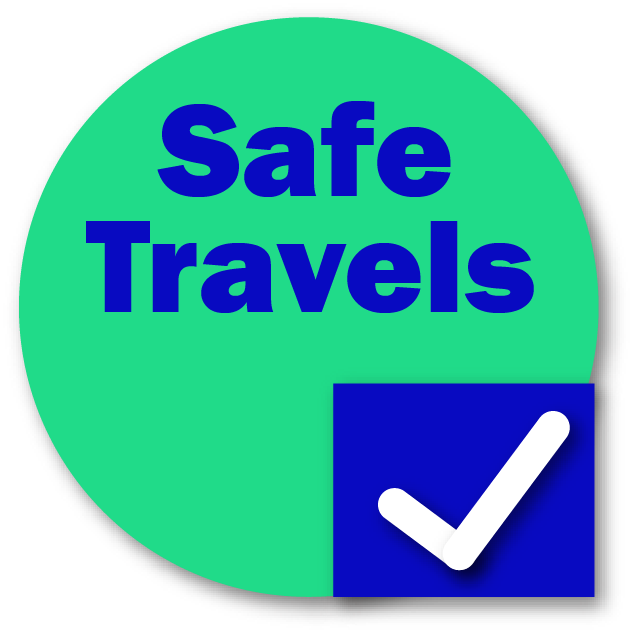




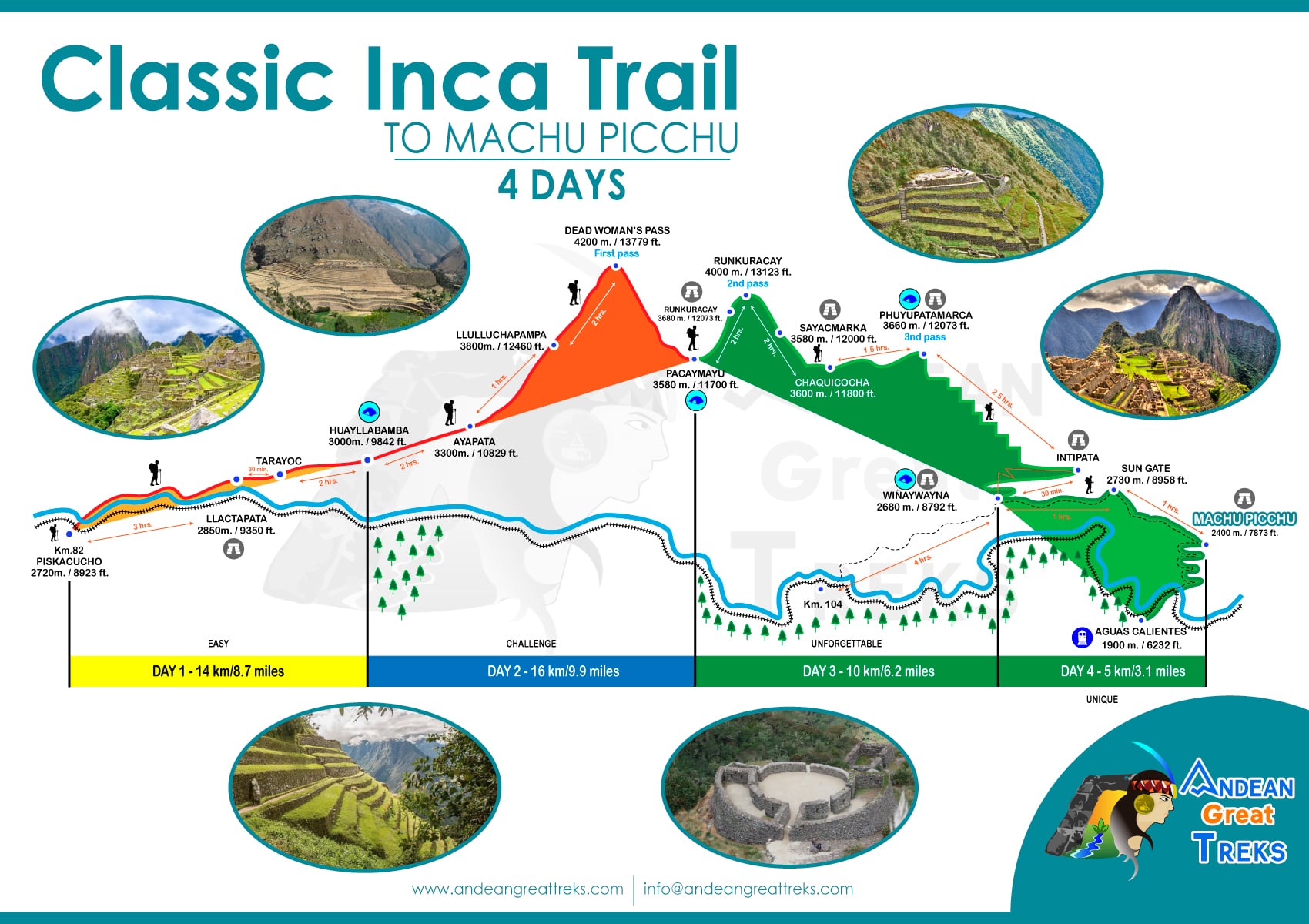 trip overview
included
Trip Highlights
activities
accommodations
itinerary
packing list
faq
essential trip information
best season to travel
price & availability
reviews
Reserve Online
trip overview
included
Trip Highlights
activities
accommodations
itinerary
packing list
faq
essential trip information
best season to travel
price & availability
reviews
Reserve Online
 CREATING AUTHENTIC TOURS IN PERU
CREATING AUTHENTIC TOURS IN PERU

The Inca Trail Express to Machu Picchu is considered one of the best treks in the world due to its exquisite beauty and natural environment. This includes different ecological areas from high Andean hills to rainforests. Following this ancient Inca Trail Tours, passing through mysterious archaeological inca houses, temples, and royal residences covered by vegetation environments, creating the impression of being discovered for the first time, to finally reach the lost city of the Incas: Machu Picchu. Our adventure is led by expert local tour guides who will ensure that your trip safe and enjoyable. We work only in small groups and with the best camping equipment, our cooks are the best with a great experience preparing the best food for your enjoyment.
Discover the majestic and the mysterious, deep in the land of the Incas. Through lush valleys, cloud forests full of pristine flora and fauna, which still remain unchanged since the time of the Incas (more than 500 years ago). Peru is full of treasures, culinary delights, cultural heritage, and archaeological wonders, many of which you will witness on this Peru tour.
The Inca Trail Express is a route with a challenging hike in terms of physical conditions, hikers must have the habit of riding a bicycle, walking in the morning, running, the body must be prepared for a great walk through various ecosystems. Be prepared to withstand different weather conditions, where you will earn more than 1000 meters per day. Remember that this hike is the same as hikers do in 4 or even 5 days. Generally, you will walk more than 15 km per day, with stairways going up and down, as well as very steep hills.
Camping Tents on Inca Trail: 2 nights
The overnight stays during the Inca Trail are made in double-roofed tents, which are installed by the accompanying team. The tents are equipped with thick foam mattresses that are carried by the porters. Sleeping bags can be rented on site for a fee prior to the start of the trek. The camps have permanent sanitary facilities, some have toilets, but most of them are of the “squat” variety. They may not be the most hygienic, but try to use them instead of nature, remember you are in one of the most amazing natural environments in the world. Please bring toilet paper with you. A dining tent offers enough space to eat together and end the evening in peace.
We pick you up at 4:30 am at your hotel then we take you in our private bus to Ollantaytambo. Afterwards we drive to Piskacucho, where our trek begins. After crossing the Urubamba River we follow the left bank before ascending to the Inca ruins of Llactapata (2,565m/7,505f). From the ruins we continue our hike as far as the Village of Wayllabamba (2,743m/8,997f), where we eat lunch. From there the trail climbs steadily through high Andean woodland to a plain called Llulluchapampa just before the Inca Trail’s first pass, where we will set up camp.
After an early wake up around 5:30am for breakfast, we begin to climb from Llulluchapampa to the highest pass on the Inca Trail to Machu Picchu, the death woman Pass 4217m/13,907ft , where there are excellent views of the Wayanay Mountain. Afterwards we descend to the Pacaymayu River. From here, the trail climbs to the second pass at Runcuracay, from where we will be able to see both the Vilcabamba and Urubamba mountain ranges. After a short rest we will descend slowly along a paved Inca road to the restored ruins of Sayacmarca. Here we enter into the cloud forest, by afternoon the trail descends via a stone stairway to the ruins of Phuyupatamarca, where we will camp for the night.
Another early wake up, around 3:00 am, from Phuyupatamarca (3,700m/12,136f) we hike downhill to the beautiful Inca ruins of Wiñaywayna (2,699m/8,853f). After visiting these fascinating ruins we will hike along a section of the trail renowned for its subtropical flora and fauna for about two hours, arriving at Intipunku (Sun Gate) early morning. From there we will get our first glimpse of Machu Picchu. Once inside the citadel, we will be given a 2 hour guided tour around 8:30am to 9:00 am with plenty of free time for further exploring more places by yourself. Then we will take our bus to Aguas Calientes and by evening we will come back to Ollantaytambo by train; then by bus to Cusco arriving to the small square of San Francisco at 22:00 pm approx.
When packing for your Classic Inca trail , you should keep in mind that it is best to dress in layers due to the weather variation. The variety of clothes that you must pack to dress in layers is key to your walk, from the morning when it is quite cold until mid afternoon when the temperatures rise and reach their peak and then freeze again at night. Stratification is also useful as you ascend high passages that are exposed to winds or descend into shady valleys.
Effective stratification only works if each layer allows moisture to pass and escape into the external environment. In fact, the best layered clothing, such as wool, promotes moisture transfer through its absorbent properties. Cotton and denim absorb moisture and, therefore, should be avoided.
 warm jackets
warm jackets
 Hydration bladder
Hydration bladder
 wool socks
wool socks
 camera
camera
 scarf
scarf
 first aid kit
first aid kit
 hiking shoes
hiking shoes
 Dry bags
Dry bags
 Trekking Poles
Trekking Poles
 sun cream
sun cream
 Snack
Snack
 sun hat
sun hat
 bathing suite
bathing suite
 rain coat
rain coat
 Sandals
Sandals
 insect repellent
insect repellent
 Passport
Passport
 Down Jackets
Down Jackets
 toilet paper
toilet paper
 daypack
daypack
 Wool cap
Wool cap
 head lamp
head lamp
 gloves
gloves
 sun glasses
sun glasses
 cap
cap
 extra cash
extra cash
 Trekking pants
Trekking pants
Inca Trail to Machu Picchu or Inca Trail Hike – No hike in the world can be compared to the beauty that can only be seen in the Inca Trail 3 days. Besides the pleasant experience of living together with local people (porters) and tourists from different countries that you meet, at the end of the inca trail hike, you will feel very satisfied with every single step you walked along the Inca Trail 3 days. Those steps will lead you to your final dream destination, the majestic Machu Picchu, a memory you will treasure forever.
The Inca Trail to Machu Picchu provides trekkers with a fantastic opportunity to hike the Andean mountains while learning the history of the pre columbian people inhabiting what is now called South America and their encounter with the Spaniards ‘conquistadors’.
In this piece, you will find absolutely everything you need to know about the Inca Trail, which is the most beautiful hiking destination of Peru and South America.
The starting point of the Inca Trail 4 days and 3 nights Network is located in the Piscacucho km 82 community, in the district of Ollantaytambo, province of Urubamba.
Most people will get to Cusco by air. Please remember that the Cusco airport is for domestic travel only. If you come directly from overseas through Lima, you must get your bags in Lima and re-check them for your flight to Cusco. Four airline carriers fly roundtrip between Lima and Cusco. That includes LATAM Airlines, AVIANCA Airlines, Star Peru, and Peruvian Airlines. They all offer similar schedules and in-flight service, but we usually recommend either LATAM airlines or AVIANCA. They tend to be the most helpful when unexpected flight cancellations or delays occur
The Inca Trail has an extraordinary history. The Inca Empire extended into parts of what is now Colombia, Ecuador, Peru, Chile, Argentina, Brazil, and Bolivia, and the original Trail stretched approximately 25,000 miles throughout these areas. During the 15th and 16th centuries, the Trail was used as a key trade route as well as for transportation. However, parts of it were also used for ceremonial purposes and as a pilgrimage route.
Therefore, there are many fascinating theories about the purpose of the connection of the Inca Trail to Machu Picchu, which was built at the height of the Inca Empire. Some researchers believe it served as an annual pilgrimage route to honor Inti, the Incan God of the Sun, who was thought to have been born on the Island of the Sun at Lake Titicaca. It is said that the Trail follows the path of the Sun’s rays during certain times of the year, from Lake Titicaca to Machu Picchu.
The construction of the city of Machu Picchu spanned the reigns of two Inca rulers: Pachacutec Inca Yupanqui (1438–71) and Tupac Inca Yupanqui (1472–93). However, a little over a hundred years later, the city lay mysteriously uninhabited. Historians have disputed the reasons for this, with some arguing that invaders killed the city’s population during the Spanish Conquest, and others arguing that the city’s population succumbed to a smallpox epidemic, years before the Spanish arrived.
During and after the Spanish Conquest, the Inca Trail and Machu Picchu became targets for plundering and theft. It has been reported that Germans Augusto Berns and J.M. von Hassel initially found Machu Picchu during the 1800s and early 1900s, respectively. However, due to the dense forestation that had started to amass around the abandoned city, Machu Picchu became far less targeted by looters than other easier-to-access sites along the Inca Trail in Peru and in the surrounding areas. The locals may also have kept quiet to save their secret city from the aggressive looting campaigns, so by the 19th century only a few locals and academics were even aware of Machu Picchu’s existence.
In 1911, the American academic and explorer Hiram Bingham re-discovered Machu Picchu along the Inca Trail in Peru and conducted the first official archeological research there. As a seasoned adventurer (due to childhood expeditions with his father) and a keen Latin American history scholar, Bingham spent time traveling the Spanish trade routes throughout South America. As a Yale University history professor, he organized a group of scholars to set out and find the ‘lost city.’
Then, on July 24, 1911, a local guide directed Bingham to the ruins of Machu Picchu. Once there, he and his team started to explore and excavate the area, with return trips in 1912, 1914, and 1915 to continue their work. Through the Yale Archeological Society, the area of Machu Picchu and several surrounding sites were excavated and further academic research was conducted. To this day, the area is still a historical treasure trove, adding much to the Inca Trail experience.
The Inca trail trek is famous because it provides hikers the only way to arrive in Machu Picchu by means of hiking. Upon the re-discovery of Machu Picchu by the American scholar Hiram Bingham, the Inca trail to machu picchu was also brought back to life.
Teams of archaeologists and local peasants explored what remained of this ancient inca trail, finding many Incan complexes and temples along the way that became some of their most beautiful attractions. Machu Picchu was named a UNESCO world heritage site in 1983, and one of the seven new wonders of the world in 2003, which made it a famous must-see travel destination.
The Inca Inca Trail Trek to Machu Picchu began receiving more tourists when Peru entered into a phase of pacification in coming out of a kind of civil war that bled the country from the early ’80s up until the mid-’90s. By the end of the last century, thousands of people flocked to this beautiful destination to arrive in the Sungate of Machu Picchu at sunrise. Only the people who hike the trail to machu piccu can experience such an event.
Just like every other outdoor activity, hiking involves a dose of risk-taking. However, the Machu Picchu hike is not dangerous at all.
There are no places where one’s safety might be compromised. In any case, the best way to minimize any danger level is by acting proactively and taking the necessary measures to prevent any such situations. For instance, proper acclimatization will prevent you from getting altitude sickness, which is the number one reason why people fall ill.
Taking a trip to any historical landmark in the world of the caliber of Machu Picchu demands preparation about the background of such attractions. Here is a list of a few books and videos that you should consider reading before your Machu Picchu trip:
A few videos you can watch:
The best way to ensure that one will hike the Inca trail successfully is by arriving in Cusco at least three days ahead of your departure time. These three days will give you the necessary time to acclimatize while you get to visit some of the beautiful attractions that you can visit in Cusco.
Arriving in Cusco by plane. Most people fly into Cusco, coming directly from Lima after their international flights. Lima holds the most important international airport in Peru, and almost all international flights must land there before people connect to their final domestic destinations. Cusco’s airport is the second busiest airport in Peru; most flights arrive from Lima while some others do it from cities like Arequipa, Juliaca, Iquitos, Puerto Maldonado, and Trujillo. As far as international flights, Cusco’s airport receives flights coming from Bogota, Colombia, Santiago de Chile, and La Paz, Bolivia. The most important and safest Peruvian airlines are Lan Peru and Avianca. Other budget airlines are SkyPeru, Peruvian Airlines, and Gol Peru.
Arriving in Cusco by bus and train (overland). There are plenty of comfortable bus companies servicing Lima and Cusco on a daily basis. The bus ride usually takes up to twenty hours of driving. Traveling to Cusco from Lima by bus is not advisable. Most people who do arrive in Cusco by means of bus do it after following an itinerary that allows them to visit a few other interesting tourist attractions along the way. Places like Paracas Marine National Reserve or Poor Man’s Galapagos, the Huacachina Oasis in Ica, and the Nazca Lines are some of the must-see attractions one can visit on the way to Cusco. There are a few hop-on/ hop-off tour operators that allow you to visit those places by purchasing one full ticket between Lima and Cusco. Also, plenty of night buses run from Arequipa (the second-largest city in Peru) to Cusco. Arequipa is a beautiful colonial city where one can visit the Colca Canyon and see the flight of the condors. Also, many people choose to climb the Misti and Chachani volcanoes in this area.
As far as trains, Cusco connects with Puno, from where Peru rail runs a few different tourist trains.
THINGS TO DO IN CUSCO BEFORE THE INCA TRAIL TREK
Cusco is the most beautiful city in Peru and one of the most beautiful cities in South America. It is a place that deserves time in its own right to be explored and enjoyed. As I mentioned above, one of the most important reasons to arrive in Cusco a few days ahead of your Inca trail tour is to accelerate the process of acclimatization to the altitude. To do this smoothly and perfectly, then we recommend the following things to do:
Day One. Go for a walk of your own or take a walking city tour of Cusco. This is a great way to experience Cusco upon arriving. In these tours, you will see some of Cusco’s most impressive attractions, such as the Main Square or Plaza de Armas, the San Blas neighborhood, and the San Pedro central market. These walking city tours usually take up to 3 hours. Make sure you book for an afternoon city tour to give your body some time to first adapt to the altitude.
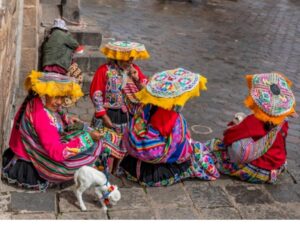
Day Two. Take the Rainbow Mountain tour or the Humantay Lake tour. Climb high, sleep low is one of the best practices that hikers perform when hiking at high altitudes. One of the ways people can quickly adapt to the altitude is by climbing either the Humantay Lake or the Rainbow Mountains. By doing so, one actually gets to do what is mentioned above as people will climb to altitudes above 13,000 ft and return to Cusco’s altitude of 10,500ft in the afternoons.
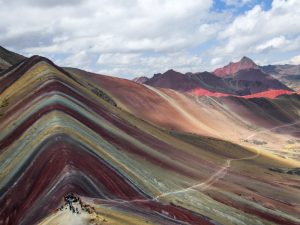
Day Three. Take it easy, or take the magnificent Sacred Valley tour. We recommend that you make your hotel reservations for this night in places like Urubamba or Ollantaytambo. You can check with your inca trail tour operator and ask them to pick you from either of these locations the following day. If you stay at either of these locations, you will save yourself the two-hour drive back to Cusco from Ollantaytambo after completing the Sacred Valley tour and the two hours from Cusco to Ollantaytambo on the day of the tour. Additionally, this decision will give you two more hours of sleep on the day of the hike as you won’t have to get up at four in the morning to be transported to the start of the Inca trail to Machu Picchu.
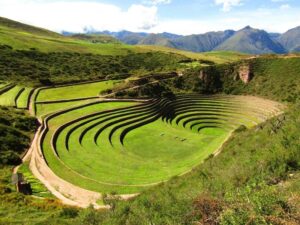
After you have experienced some of what Cusco offers, it’s time to turn our attention to the Classic Inca Trail tour. To hike this route to Machu Picchu, you are required by the government of Peru to hire a licensed guide service or tour company with the required permits to take trekkers on the journey.
The company you choose will often arrange road transportation from Cusco to the start of the inca trail trek, with pickups that generally occur early in the day (around 4:00 AM local time). The most popular place to start the hike is known as Kilometer 82, which is the start of the Classic Inca Trail route. Once you reach this location, you will generally conduct a gear check, fill up your water containers, and make sure everyone is fully prepared to start the journey.
Along the trek, you will walk through different terrains, and experience diverse microclimates and altitudes. All of these factors contribute to the great biodiversity that is unique to this area.
Cusco has two distinct seasons: dry and rainy. However, in these two seasons, you can experience the different microclimates of each town. The microclimate varies according to the altitude you are at. Having that said, you will notice that the climate in Machu Picchu and along the way varies. You will hike from an altitude of 2050 m.a.s.l. to 4200 m.a.s.l.
Rainy season: From November to April. During this time Cusco receives a greater amount of rainfall. Average daytime temperatures are higher than the dry season at 23 °C while night temperatures can be as cold as 6 °C. Likewise, Annual rainfall is 160 mm. During these months, it is cloudy and humidity can reach 91%.
Dry season: From May to October. Days are bright and sunny with a temperature of 22 °C (61 °F) while nights are much colder sometimes with a low temperature of 0 °C. Likewise, Annual rainfall is 60 mm. It is sunny with a clear sky and 70% of humidity.
Because of high altitude temperatures can change quickly and radical. It can get pretty cold during the nights. In winter (May-September) temperature may drop below 0°C/32°F. So be prepared for cold too, its highly advisable get locally made gloves and a hat for the cold nights.
The best season to do the Inca Trail hike is during the dry season. However, you should know that whether you come in the dry or rainy season, it will have advantages and disadvantages.
We covered the process of obtaining your permit, but it may also be helpful to understand the best times of each year to hike. The most popular time to hike the Inca Trail is between April and September. With the rainy season in Peru over, most tourists and travelers will have planned to take their trip during these months. The trail itself is open for 11 months of the year, but all tours are closed in February for environmental and archeological maintenance. The mountains Huayna Picchu and Cerro Machu Picchu, which are both part of the Machu Picchu sanctuary, are temporarily closed each year for maintenance (in recent years, they have been closed at different times in April, though this may not always be the case and the timing of closures can be variable going forward.
January and March
During these months Inca Trail tours are relatively uncrowded, wet, and certainly fun if you enjoy a bit of a challenge. Fewer tourists and fewer queues when you arrive in the city can mean that traveling to and around Machu Picchu in the winter season has its advantages. Because Machu Picchu is considered to be a shrine to the Inca Emperor Pachacuti (1438–1472), hiking at this time of year can highlight the quiet beauty that this site was created to be appreciated in.
April
Lovely and temperate, April is an excellent time for an Inca Trail Machu Picchu tour due to the firmer ground and clearer weather. Photography can also be quite fortuitous in April if you want to capture some high-quality pictures of Machu Picchu and the surrounding forests.
May
Gorgeous weather for hiking the Inca Trail and reasonably dry, May is a great time to visit Machu Picchu as well. Be aware of booking and travel costs, though, as May is the start of peak traveling season for university/college students. Flights and accommodations can get somewhat expensive if you don’t plan well.
June, July, August, and September
These are the most popular months to go hiking on the Inca Trail and/or to visit Machu Picchu. With dry weather, very little rain, and cooler nights, hiking during these months is generally more comfortable than at other times of the year. The downsides can include the challenge of securing accommodations and trail permit reservations, as they will be scarce.
October
With fresher, cool temperatures, this is great weather to hike the Inca Trail. Although it is colder than many of the other months, October is reasonably dry and falls outside of holiday periods, making it a great time to go hiking in Peru in general. The off-peak season provides choice hotels and quieter experiences when traveling and dining, as well.
November and December
November and December feature surprisingly good weather for hiking the Inca Trail, with minimal rain. Just before the winter break, the queues and attractions in Machu Picchu and surrounding areas are busy but not overcrowded. Also, the hotels near Machu Picchu and transport are still reasonably quiet.
Conclusion
There you have it, an introduction to the need-to-know essentials for hiking the Inca Trail and visiting Machu Picchu! We hope this guide has given you an informative and helpful idea of what to expect as you plan your one-of-a-kind adventure to Peru. If you have any additional questions on hiking to or visiting the iconic Machu Picchu citadel, please do not hesitate to contact us.
Tips: It is important to pack light and consider the climate of the time of the year you are coming to do the inca trail 4 days. If it is during the rainy season, you need to buy a rain poncho and bring a raincoat. Wear always sunscreen no matter the time of the year.
There are two main Inca Trail tours. First, the Classic Inca Trail which takes 4 days and 3 nights to complete the hike and the shorter 2 days Inca Trail, the easier and faster way to reach Machu Picchu, but you still experience the last part of famous Inca Trail (you basically will be avoiding second day hike).
Additionally, in case of no available permits, there is a number of alternative tours to get to Machu Picchu such as the tours of Machu Picchu by train or the tour which combines biking, hiking and Machu Picchu tour in 4 days and 3 nights.
Actually, there is no government restriction on the age limit for the inca trail to machu picchu. However, because of the challenging trek, we consider it to be best for visitors above 15 years old to 55-year-old adults. Of course, they must be in good physical condition. Certainly, In case a child travels with you, you may need to hire the service of a personal porter who will assist your child along the hike and carry his backpack.
Above all, Adults over 55 years old, should have hiking experience and be in good health condition. This way, they will be able to arrive in Machu Picchu safely.
Most importantly, Training in advance is the key to succeed on hiking the Inca Trail to machu picchu. Without it, you may not be able to complete the circuit since the inca trail 4 days presents different types of terrain which go from easy to challenging levels to finally arriving in Machu picchu.
So, performing some activities at home or at the gym will make the difference. You can do activities that make the legs, arms, heart and back work. Consequently, when you start the Inca Trail, your body won’t struggle at the difficult parts; instead, you will be better prepared and, as a result, enjoy the view more. It is recommendable to start training at least 3 or months before your travel date.
Likewise, breathing exercises can strengthen chest muscles and make breathing easier during the inca trail to machu picchu. This way, high altitude won’t be a problem for you, not even the 4200 m.a.s.l., which is the highest point of the inca trail 4 days you will be at.
Although, it is not mandatory to have travel insurance to do the hike Inca Trail 4 days, we highly recommend getting one. This way you can prevent any inconvenience that can happen during your trip such as a flight delay, strikes in the country or city, a natural disaster, or getting sick during the inca trail hike.
To sum up, You should know that getting sick in Peru may be a bit more expensive than other countries. So, Getting travel insurance will make you feel more secure. Insurance companies normally charge you from 100 to 150 US Dollar. Here you have a list of some insurance companies:
A compact three-season sleeping bag is recommended. It’s also possible to rent a sleeping bag in Cuzco. They are clean, warm and cost approximately USD$20 (for the three nights). You may also bring a sleeping bag liner or sheet. Foam mats are provided however some travelers also bring their own self-inflating mat. Sleeping bags are not included.
As one of the most frequently asked questions, the highest point of the Inca Trail is at 4,200 meters above the sea level, you will spend the night at the campsite at 3.600 meters. It is difficult to say if you really going to suffer from altitude sickness, people are different and are prepared physically different. Most hikers don’t have any issues, but two days rest in Cusco to acclimatize is very advisable, drinking water and chewing cocoa leaves will definitely prepare you for the Inca Trail.
Most people have that concern but don’t worry. Only in extremely rare circumstances does a passenger need to come back early. You just need to remember that you are able to go at a speed that is comfortable for you. Take your time, pace yourself, and enjoy.
The Inca Trail is considered a moderate hike. It’s not a technical hike but there are a lot of Inca stairs to walk up and down, and the altitude may affect some individuals. We recommend using a trekking poles and have an early night before to start the Inca trail trek.
The physical rating on the Inca Trail is level 2-3. On Day 2 of the Inca Trail you will be walking uphill from 3000 to 4200 meters above sea level before descending steeply through big steps and difficult terrain. While this demanding walk is the main challenge our passengers face on this trip, it’s also one of the highlights and worth every minute of it.
We recommend that you undertake regular aerobic exercise in the months before you travel, particularly if you are not in the habit of regular exercise. Doing mountain walks or climbing long staircases with a pack is good preparation. Walking, jogging, swimming or riding a bike are all good ways to increase your aerobic fitness, which will allow you to enjoy the trekking to its fullest.
While you don’t need any specific training to do the 4 Day Inca Trail, being fit will help. The best preparation for the trek is treadmill exercises with steep inclines and stairs. The second day will be your toughest day, as you will climb up two peaks that day.
From 1 to 5 it’s 3, moderately difficult. The Inca stairways to walk up and down in different temperatures and high altitude all that makes this level of difficulty. You can rent walking poles before you start your hike. Those will help you in many ways, we would recommend you get ones if you have some issues with knees or ankles, poles would absorb some pressure from those parts and also help to keep your balance! We recommend you to have a look how to prepare yourself for the Inca Trail.
During the inca trail 4 days, you will not have Internet connection. Therefore, using a cellphone or any electronic device is not convenient in most places.
To keep in contact with the administrators of the tourist agency and inform them in case of a problem, or to check something important, we use radios or satellite phones.
First and Fourth day: you will have internet connection.
Second day: there is no internet connection.
Third day afternoon: there is internet connection.
However, you will have internet connection at the campsite in Wayllabamba on day 1, it has a cost of 5 to 10 soles ($2 or $30) per hour. You will also have internet connection at the campsite of Phuyupatamarca until you arrive in Machu Picchu, and you will be able to make calls, too. The telephone operators that have better signal are CLARO and BITEL. Other telephone operators don’t have good signals along the inca trail hike, but once you arrive in Aguas Calientes town, you will be able to communicate with your family or friends.
In the scenario that you are unable to finish the inca trail trek due health issues, Andean Great Treks will do everything in its power to get you to the nearest civilization and get help or transportation to help. If the issue is respiratory or due to altitude, we do carry at least one tank of oxygen on trek that you will have access to. In extreme cases, a helicopter pick up can be arranged at your own expense. (Travel Insurance required) There are no refunds in the situation that you are unable to finish though.
Generally if due to altitude sickness people can´t make it over the pass on the 2nd day of the inca trail they come back to Ollantaytambo accompanied by a porter if just mild (or guide if serious) and if they recover from altitude sickness they stay the night here in Ollantaytambo and then take the train to Aguas Calientes the next day (Day 3) in the afternoon , you will spend the night in any hotel in aguas calientes, and rejoin your group in Machu Picchu early on Day 4 and continue the tour as normal. The additional costs for this such as train ticket and accomodations will be payed by the customer.
Yes we are able to accommodate many types of dietary needs upon request at the time of booking. If you are a vegetarian, or cannot eat gluten or have allergies to certain foods, it will not be a problem. The meals of our chefs on the inca trail hike are one of the most popular parts of our tours too, and the quality will not be reduced when accommodating your dietary needs. The meals are served buffet style and you are able to choose what you would like to eat. Your guides will let you know what time the meals will be served.
Our inca trail cooks prepare excellent high-energy meals appropriate for a classic inca trail trek of this nature. The menu usually includes quinua, cereals and vegetable soups, Beaf Lomo Saltado with rice, chicken cacerole, fresh fruit and vegetables and a variety of oatmeal, eggs and other breakfast foods as scramble egg, quinua panqueques.
There is no drinking water in Inca Trail 4 days. We will provide boiled water at the campsites. You need to bring a camelback or water bottle which will be refilled.
Therefore, this will be provided on the day agreed with the agency you have hired which can be since the second or third day. It is also recommendable to bring pills or water purification bottles, ultraviolet water purifiers, portable suction filter or portable filtration pump. This way, you could drink water from the rivers and streams.
You can buy them at some points of the inca trail hike, from day 1 to day 2 (Llulluchapampa). However, you will notice that they cost a bit more than in the city. And with all reason since it implies a great effort to take these products from the city to these areas not only it is expensive but also challenging for the altitude.
We include some snacks in our tour. However you can contribute to local small businesses. You should know that tourism is a form of economic growth for families that live in the high Andean regions where the main activity is agriculture.
There are different kinds of campsites on the inca trail hike each night. That is to say, some of them don’t have restrooms and showers. Having that said, we will mention what you will have at each of the most popular campsites:
Wayllabamba (1st campsite):
There are bathrooms that belong to the local people who rent them to the tourists. They cost S/ 1.00 to S/ 2.00.
No showers
Pacaymayu (2nd campsite):
There are bathrooms and showers with cold water. Since they are property of SERNANP, they are free.
Wiñayhuayna (3rd campsite):
There are bathrooms and showers with cold water. Since they are property of SERNANP, they are free.
So, If you are traveling with a tourist agency, there is no need to worry about the restrooms. The tourist agency will carry portable toilets. Some of the porters will carry the portable toilets that tourists will use. At this point, you may wonder who carries the waste of the toilets. If so, you should know that since waste can’t be thrown along the inca trail hike, porters carry this type of waste in special bags.
The inca trail trek is perfectly safe during the rainy season. Some people actually like to go during the rainy season because there are fewer tourists. If you are one who doesn’t mind the rain, then we say ‘Go for it!’ You will just have to bring good rain gear and waterproof boots.
Yes, you do need a permit to hike the Inca Trail Trek to Machu Picchu.
Everyone who hikes along any of the four routes of the Inca Trail network of roads to Machu Picchu must have a permit.
This is includes tourists, tour guides, porters, and cooks.
According to the ‘Plan Maestro’ or ‘Master Plan’ of Machu Picchu, elaborated by the Ministry of Culture of Peru and Sernanp (National Service of Natural Protected Areas) in 2003, only 500 people a day can access this place, Roughly 300 of them are porters and 200 are tourists.
Also, 300 people a day are allowed to enter the Short Inca trail trek.
Fitness is important but more important than that is acclimatization and experience.
In the world of trekking, hiking for one day is one thing; hiking and camping for several days is another, while hiking and camping for several days at high altitudes is an entirely a different situation.
No matter what category you fall into amongst those three levels, the Inca Trail Hike is not recommended for people who have never hiked, nor is it advisable for people who suffer from heart or respiratory problems.
If you are capable of hiking at sea level for at least 5 hours non-stop, then you are very likely to succeed at inca trail hiking to Machu Picchu
What will determine your success is the time acclimatizing to Cusco’s high altitude before the inca trail trek, the weight that you carry in your bag, and the psychological commitment that one devotes to it.
Age is also not a problem; there have been people in their late 70s or early 80’s who have completed the full length of the inca trail to machu picchu.
Also, hiking at high altitudes might be difficult for heavy smokers and other people with breathing conditions.
Most inca trail tour operators will gather the members of their group tours in one location where they will meet their tour leaders and receive a pre-trek presentation with all the details about their journey. On this occasion, you will have the last chance to re-check dietary options, update passport information, and hire the necessary camping gear and extra porters. Be sure to attend such a gathering and ask the essential questions.
Taking the time to hike the Inca Trail to Machu Picchu is worth every penny. The trek is considered to be one of the greatest adventure experiences on the planet. There are very few places where you have an opportunity to walk through awe inspiring terrain while passing 500 year old archeological treasures. And at the end of your adventure you are rewarded with a breathtaking view of Machu Picchu.
The Inca Trail, or the Camino del Inca, is one of the most important features of South America’s past and present, and the trek to Machu Picchu is unlike any other adventure in the world. There are very few trails where you can actually walk through history like this. On this adventure, you will continuously encounter 500-year-old Incan archaeological sites, and at the end of the trek, you receive a great reward as you ascend the Sun Gate and reach the legendary Machu Picchu site.
Another factor that makes the Inca Trail to Machu Picchu trek one of the best adventure experiences on the planet is the diversity of the terrain that you will encounter along the way. Whether you are climbing stone staircases, crossing wooden bridges over rivers, weaving through tropical jungles, or navigating through cloud forests surrounded by mountain peaks, it is truly once-in-a-lifetime journey. Along the way, you may even spot curious llamas, alpacas, spectacled bears, enormous condors, and various other fascinating Peruvian fauna!
The high-altitude ruins of Machu Picchu are located on a mountain ridge 7,972 feet above sea level at the end of the Classic Inca Trail Route, in the Urubamba Province of Southern Peru. When looking at a map or satellite imagery of Machu Picchu, you can see that it is hidden within deep forestation, 50 miles northwest of Cusco (the former Inca capital).
Known as one of the ‘New Seven Wonders of the World’ and officially recognized as a UNESCO World Heritage Site, there are plenty of excellent reasons to visit Machu Picchu at least once! As the most widely recognized surviving symbol of the Inca Empire and one of the most important archeological sites discovered on Earth, this Andean landmark is guaranteed to excite even the most experienced adventurer. Striking in both its natural beauty and rich cultural heritage, thousands of people come from all over the world to explore the site each year, and the ancient site has in turn inspired countless musicians, artists, and photographers. The Inca Trail to Machu Picchu trek is for any adventurer who is ready to travel back through history and follow in the footsteps of our Inca predecessors.
There are multiple water sources along the Inca Trail, such as streams or rivers. Most tour companies utilize either a pump filtration system, boil water, or combine both methods in order to purify water during the inca trail trek. Typically, you will be provided with potable water three times per day: at breakfast, lunch, and dinner. It is essential that you fill up your water containers each time you have the opportunity because the hike can be strenuous, and temperatures can get hot during the day. In our experience, we have seen many other trekkers on the Trail run out of water prematurely because they underestimate how much water they will require. We recommend that you have a minimum of 2 liters of water for both the morning and afternoon treks. Depending on your personal preferences, you can either use 32 fluid ounce (1 liter) Nalgene bottles or reservoir-type water systems (such as Camelbak). It is also wise to have salt tablets or electrolytes to add to your water. Additionally, if you are the type of person who likes to be extra prepared, the below items are popular options as a personal backup:
The visiting time in Machu Picchu citadel is an average of 1 hour and 45 minutes to 2 hours. This is enough time to visit the main circuit that includes the most important sites of the historical sanctuary. Once the guided tour is over, you won’t have much time to visit the site on your own. However, if you have bought the entrance tickets for either Huayna Picchu or Machu Picchu Mountain, the extra hikes, you will have the chance to enter the site a second time.
Huayna Picchu: Average time of the hike is 1 hour and 45 minutes roundtrip. The climb is steep and has small stairs. Therefore, this extra hike is not recommendable for children.
Machu Picchu Mountain: Average time of the hike is 2 hours and a half roundtrip. This extra hike is more recommendable for people who travel with children.
Something important that any traveler must be aware of is the regulations of the Inca Trail to Machu Picchu that entities such as SERNANP and DDC-Cusco have established in order to preserve the route. Therefore, we will mention some of the main regulations to hike the Inca Trail 4 days.
You aren’t allowed to hike the Inca Trail Hike on your own. To hike the Inca Trail 4 days, you need to hire the service of a licensed tour operator.
You can’t buy the permits on your own. Only licensed tour operators can get the tickets for you.
Groups shouldn’t exceed 8 tourists. If they are more than 8 people in the group, there must be an extra assistant.
Permits have to be bought in advance since there are limited spots. You can’t buy permits at the checkpoint.
It is not permitted to camp at unauthorized sites.
Above all, It is important to be aware of these regulations and follow them. If not, park rangers will approach you and you will receive a fine for any damage caused.
The permits or entrance ticket for the Inca Trail Hike includes the entrance to Machu Picchu citadel, but it does not include the entrance to the extra hikes to the mountains from where you can see the citadel from above.
For example, Huayna Picchu mountain costs $80 USD per person. In case, you want to hike it you have to buy the entrance ticket to the mountain in advance.
Of course, if you are ok with taking the same train out of Aguas Calientes that is part of your original itinerary, which is typically at 14:00PM that evening than there is no additional charge to move the train back a day. If you need us to secure your hotel or another visit to Machu Picchu, this will be an additional cost. If you do choose to spend one more night in Aguas Calientes, make sure you tell the Andean Great Treks office at least one month in advance, so your train ticket is purchased for the right day.
Most of the groups reach the Sun Gate at approximately 6.00 am. On the 4th last day of Inca trail. You will start hiking towards gates at 4.30 am and will enter the site 45 min. later. The time may vary a little that depends on the placement of campsite, which we will assigned on the last night.
Will I be able to witness the sunrise at Machu Picchu?
In truth it is not typical sunrise. As long as you don´t have too much mist or low cloud then you see the first light illuminating Machu Picchu. It is after dawn though as the sun must rise up over the high mountains surrounding Machu Picchu.
If you are wanting to include an ascent of Huayna Picchu in your visit to Machu Picchu, note that The trail to Huayna Picchu is safe but very vertical and is about an hour and a half round trip beware that there are new regulations since July 2018 and permits have to be bought in advance. If you want us to organise your permit to climb Huayna Picchu and we must have this request in writing and confirmed at the time of your booking indicating you will pay the extra for this permit. Deposit for Huayna Picchu permit is $80 usd .
BUT remember, so in case you will book the huaynapicchu mountain, you will lost the tour guiding in Machu Picchu, because our tour guiding starts at 9:00 am and ends at 11:00 am. So the time to climb up Huaynapicchu is at 10:00 am. And you will not able to go to both places at same time.
When the Inca trail tour is done, we arrive at the citadel at 8:30 am. After a 30-minute break to use the bathrooms, and eat a snack. It begins with the guided tour at 9:00 am. The complete circuit takes 2hrs approx. Then we will all retire as it is not allowed to stay longer in the archeological site, by rules of protection of the Sanctuary. At 12:00 pm approx. We must get off by bus to the city of Aguas Calientes where you can have lunch, and then take the train back to Aguas Calientes.
Upon arriving in Machu Picchu on the last day of the inca trail hike, travelers will be invited to take a guided tour of Machu Picchu. This tour comprehends a visit to the most important places of interest of Machu Picchu,so that temples, palaces, astronomical observatories, houses, fountains, etc. The guided tour takes two to three hours approximately, depending on your interest in the information provided by your tour guide. The guided tour of Machu Picchu takes place along any of the different circuits that the Peruvian government has established. Every tourist circuit runs in a one-way direction, which has a different duration and difficulty level.
Small, ten-litter backpacks are allowed inside the archaeological site. We advise that people take their passports, entrance tickets, small one-liter water bottle, sunscreen, bug spray, sunglasses, cap, and rain gear or rain poncho. Make sure to use the toilets before heading for the guided tour, as there are no toilets inside Machu Picchu. Large backpacks must be left at the luggage storage outside the entry point of Machu Picchu. Large tripods, professional photographic equipment, drones, selfie sticks, and food are not allowed inside.
There are plenty of shuttle buses departing from outside the main entrance of Machu Picchu. The shuttle ride ends at Aguas Calientes main street. From there, there is a 5-minute walk to the train station.
Staying overnight in Machu Picchu pueblo. Those who want to have a more thorough visit to Machu Picchu then stay at Aguas Calientes (Machu Picchu pueblo) are compulsory. This town offers a wide range of hotels, restaurants, massage parlors, and shopping centers for people to remain busy.
There are plenty of tourist trains departing from this town bound to Ollantaytambo and Cusco. The train ride to Ollantaytambo takes about two hours, while the train ride to Cusco takes four hours approximately.
There are limited spots for the Inca Trail, only 500 spots. These spots are not only for tourists but for guides, porters, chefs, assistants who will assist you along the inca trail to machu picchu. This means that about 230 spots are for the staff mentioned and only 270 spots are available for tourists. Before booking your tour with any licensed tour operator, make sure there are spots available for your desired date. Otherwise, you won’t be able to do Inca Trail 4 days. Remember that permits are sold fast.
Andean Great Treks is considered the number one ethical tour operator of the inca trail to machu picchu in Peru.
It has been recommended widely in many renowned media platforms such as National Geographic, Lonely Planet, Fodor’s Travel, Matador Network and Al Jazeera to name a few.
In 2020, there were over 200 tour providers authorized to run tours on the Inca trail to machu picchu. Choosing a inca trail tour operator might be a daunting experience, especially considering the number of options. Obviously, you will want to find one that accommodates your budget, has a very good reputation, and offers the type of tours that you wish to take – be that a private or a group tour.
The criteria recommended for choosing a inca trail hike tour operator should consider the following points:
Customer satisfaction ratings usually can be found in some user-generated websites where people leave reviews of their inca trail trek experiences. Places like Google Business, Facebook pages, and Trip Advisor are a good place to start looking for a inca trail tour operator. However, they should not be the sole reason to choose a inca trail tour provider, as there are other important things to consider.
Ethical practices. Traveling to places like inca trail to Machu Picchu, where having superb eco practices and the most ethical treatment of the supporting staff is involved, should invite people to do more thorough research. In the case of the latter, checking in with the Federation of the Porters of the Inca Trail will help you deal with this point. As for the former, the best place to determine that will be on the trail once you complete your hiking.
Media reputation. Usually, reputable tour operators’ best practices can be found in media articles covering their activities. These online sites cover issues such as customer experience, ethical practices, and other related matters. Also, the internet has a vast array of places where one can found a list of best inca trail tour operators.
People must consider a correlation amongst these criteria in what past customers have to say and what porters and online articles have to add to that feedback.
As early as possible as many chances you have to get your reservation complete before tickets maybe be sold out quickly. We would recommend you to reserve your tickets for Inca Trail 3 months in advance for the low season (between November to March) and at least 6 months before you planning visit Peru in high season (April to October). Note that we cannot guarantee the availability so it’s on you how early you going to book and make sure there are still tickets left (check the official Inca Trail Availability).
We try to make booking as easy as possible at Andean Great Treks. We need a booking form that is completed and includes all details for the entire party on one form please, and then a $250 deposit per person. The deposits can be paid separately, as long as we have one booking form that we can use to track payments. Once we have all deposits and details, we will then book your permits. When permits are in our hands, we will send you your invoice and confirmation that everything is 100% set. All start dates, once confirmed, are guaranteed.
Only licensed Inca Trail tour operators, like Andean Great Treks, can obtain permits from the government. Once your permit is secured, the name and start date can not be changed, under any circumstance. The only information the government permits us to change is the passport numbers.
One of the most frequent questions we hear from hikers is, “Do you need a permit to trek to Machu Picchu?” On the list of necessities every traveler needs to remember when making travel arrangements, one of the most important – but also one of the most unexciting and often overlooked – is obtaining permits to hike the Classic Inca Trail to Machu Picchu route!
Because the Peruvian government protects the historic landmark for its natural and historical significance, only 500 individuals are allowed on the Classic Inca Trail tour each day from Kilometer 82. Around 300 of these will be porters, guides and other staff, which leaves room for 200 trekkers that can join the trail per day.
Due to the worldwide popularity of this trek, permits must be purchased before you leave for Peru – sometimes many months before a trip commences! These permits for Inca Trail reservations used to go on sale in January of each year. However, for the 2022 season, permits went on sale in October 2021. It is important to note that in past years, once on sales permits for April and May have sold out entirely in just a few days, and in some years permits for June, July, and August have sold out as early as mid-February. So, it pays to plan and choose your dates at least six to nine months in advance. Once you decide on the times that you would like to go , Andean Great Treks secure your permits to hike the Inca Trail.
If traveling in a group, it is essential that your group or party reserves Inca Trail permits in a contiguous ‘block’ at the same time. In our experience at Andean Great Treks, we have seen several instances of a group or a family unit not doing this despite warnings. As a result, some of these parties have not been able to hike the Trail together as a group. Even a few minutes or hours can make a difference!
Please also note that the permitting system is carefully structured to prevent people and organizations from abusing it. Travel companies and tour operators cannot buy Inca Trail permits in bulk to resell at a later date. In order to obtain a permit, you will need to provide a full name, date of birth, passport details (passport number, country of issue, date of issue, and expiration date) and the dates you want to trek the Trail. Once the application for a permit is submitted, it typically takes anywhere from 24 to 72 hours to get a response from the Peruvian permit authority (through the Peruvian Ministry of Culture). This means that until a successful confirmation is received, you should not book flights to or hotels in Peru. Also, be aware that you will be required to pay a security deposit when initially booking the permit. If the permit is not secured for any reason, this deposit can be refunded. When a permit is successfully secured and paid, the deposit is no longer refundable.
Another critical thing to know is that after a permit is secured, you cannot change travel dates. If you can no longer go on the trek as scheduled for whatever reason, you will forfeit your deposit and the permit will go unused. Unfortunately, you can not transfer your Inca Trail permit to a friend or family member.
If you get a new passport after securing a permit, you must contact your tour operator to resubmit the new identification information to the Peruvian permitting authority. Please ensure that the passport you bring with you to Peru matches the permit’s details – otherwise, you will not be allowed to begin your Inca Trail tour! If you changed your passport, it would be wise to bring both the old and new passports to Peru. There are multiple permit checks performed along the way, and the agents are thorough!
To hike the fantastic Inca Trail 4 days, you need to bring your personal identification documents. The names in the permits must match the information in your documents. Therefore, make sure you provide accurate information to the agency you are booking the tour with. If the information is not accurate, you won’t be able to do the Inca Trail hike:
You must bring with you any of these personal documents that you used at the moment of booking. Otherwise, you won’t be able to do the Inca Trail 4 days. Make sure you have your personal documents with you all the time. Put them in a safe place before and during the inca trail hike.
Note: If you have updated your passport some days prior the trek, you have to let the agency know and ask them to update the new information. If possible, bring both the old and new passports. You should also send a copy of both the old and new passports to the agency.
Certainly, There is a small discount that the Culture Ministry gives to minors or students who have a valid student card. A student card is considered valid if it shows the following features:
Expiration date, which has to be the year that the student visits Machu Picchu (NOT a year early or later to the visit date)
Note: To apply for the students discount, you shouldn’t be over 25 years old.
The government will only allow us to change passport numbers if we have a copy of the new passport and old passport. If you no longer have your old passport, any government issue ID will be accepted, as long as the name is the same. Also, make sure your passport does not expire six months or less from your trip.
The only time that you can change your dates with no penalty charge is, if we have not purchased your permit yet. Usually we try to purchase the permits, at the most, the same day yo do the reservation for the Inca Trail.
If we do not already have your permit you can change your date. If we already have your permit, the penalty to change is US $150 and there must be availability for the date which you want to move to.
The Park of Machu Picchu requires a valid passport to issued your permit to the inca trail hike,best case is to organize your new passport in advance if that is the case. There is the possibility due to the limits of spaces on your requested date to book with your old passport number, them we can do a paperwork to change it.
There is very little possibility of a cancellation of inca trail trek by the DRCC (Park Office) even under extreme weather circumstances or even in case of a strike there will be no cancellation. The DRCC or Andean Great Treks cannot change the date of inca trail trek if there is a general strike. We do everything possible to ensure you get to the inca trail head to start the trek .
Only licensed and authorized inca trail tour operators are able to book a permit for travelers.
Every year, on October 1st, inca trail permits become on sale for all tour providers who must compete for these permits on a first-come, first-served basis.
To secure a inca trail permit, they must submit the necessary personal information of their clients, together with a partial payment and those of the porters and cooks that will assist them along the trail.
April, May, and some dates in June and July usually sell out quickly.
It is recommended that anyone wanting to take a Inca Trail to Machu Picchu hike during those months should make arrangements for these permits ahead of October 1st.
Also, all Inca trail permits are non-refundable, non-changeable, and non-transferable.
People need to be 100% sure of the dates that they are booking. Once tour providers submit their information with the park management of Machu Picchu and inca trail, it is unlikely that any changes can be made.
We work with the best brands of trekking tents, such as The North Face, Mammut, Eureka, Ferihno, Salewa, Doite, Mountain Hard Wear. Our tents for the Inca Trail to Machu Picchu are kept clean and in the best condition for the outdoors every time we finish an expedition. Normally the measurements of our tents are length (2m), height (1.2m), width (1.5m). If in case you have a larger size, we can organize a special tent for your comfort.
A very important issue to answer is that all the way from the Inca trail to Machu Picchu, you spend the night on hard surfaces, so we give you a foam mat, if you want more comfort, it is recommended that you bring your own mat inflatable.
Andean Great Treks will include a personal porter in your Inca Trail hike to Machu Picchu, who will carry 6 kg of your belongings. But if you are going to take more things for the Inca trail hike. It is possible to hire a personal porter who will be in charge of carrying your belongings, up to a maximum of 20 kg. Keep in mind that you should also carry a small personal backpack, to carry water, or a jacket. This personal porter does not keep up with your group, they leave the camp before you, and all your things will be waiting for you when you arrive. The costs to hire a personal porter are $ 120 usd for the entire tour.
Porters are humble people who live in the high Andean area of Cusco. In their communities, they raise domestic animals and are dedicated to agriculture. Therefore, It is common to see locals trading their products with people from nearby. Those are their main source of income for most families.
Porters are the backbone of the Inca Trail Hike. Their work consists of hauling all the necessary camping gear and food from campsite to campsite until the Inca trail hike to Machu Picchu is completed.
According to the Federation of Porters of the Inca Trail hike, there are approximately 8,000 porters registered with the Peruvian government based in Cusco. Most of them are men, and only a fraction of less than one percent are women. Most of them are young men between the ages of 18 and 45 who come from many distant villages located as far as 100 miles away from Cusco. A good portion of them are farmers who work only part-time, while the rest are people who have migrated to Cusco due to lack of employment and opportunities in their small villages.
Porters’ regulations. According to the Peruvian government rules in the National Sanctuary of Machu Picchu, all the male porters must carry a maximum of 20 kgs / 45 pounds – this weight includes their personal belongings and the things needed for the comfort of the tourists. In addition, inca trail tour operators should provide them with food, shelter, and gear to work in the outdoors. The average salary a porter makes for the four days of the Inca trail hike is 230 soles / 70 USD.
Women porters. Since 2017, some inca trail operators have been hiring women porters as part of a campaign to empower women. Inca Trail Tour operators should include women as porters and guides and pay them equally as men. Make sure that your inca trail tour operator guarantees these ethical practices. By doing so, you will set the conditions for your investment to go to the right hands and in the right way.
Sustainability. Most inca trail tour operators brand themselves as Sustainable, Eco-friendly, and Ethical. However, the reality of the Inca trail treks has shown that this is far from the truth. Porters are fundamental to the operations of the Inca trail treks. They perform a backbreaking job, literally. Without them, it would be simply impossible for most people to try hiking in this place.
Some renowned international media outlets have written extensively on the rights of porters and responsible travel.
The exploitative conditions in which porters have been working are unacceptable. All travelers who hike to Machu Picchu must ensure that their tour providers abide by a certain standard in which porters are treated like human beings.
Inca Trail Tour providers should ensure that porters should have decent nutritious food equal to the food tourists consume, backpacks that will not hurt their backs, and tents of the same quality as the tents tourists use.
Andean Great Treks provide everything you need for the hike. Consequently, the porters are the ones who carry all the things needed for the adventure. These things include cooking utensils, tents, food supplies, chairs, among others.
The tents will be set once you arrive at each campsite. Porters will arrive earlier than you and set everything for you can rest during the inca trail hike. This way, you will have one less thing to worry about and have a pleasant resting time.
If you are carrying some of your personal belongings such as your own camping equipment, it will be you who sets everything up after a tiring day.
According to the Porters Law – Inca Trail to Machu Picchu Nº 27607, article 3rd, the weight has been limited to 20kg. This includes a 5kg personal allowance.
When the porter is a woman, the weight limit will be reduced according to the regulations, including the 5kg of personal belongings.
All the supplies must be provided by the agency and guarantee their use. Of course, in case there is any change, it must be informed and agreed by both the employer and employee. The following are the things that each porter should receive for the inca trail 4 days.
The most important is to hire the service of tour agencies that look after their porters. You can testify how the agency you have chosen treats their porters since the first day and along the inca trail hike. So, check if they have proper outfit and if at campsites they receive quality meals. A good way to interact with them is by engaging in a conversation. Likewise, You can ask about their history and legend of the town or the importance of coca in their culture.
Don’t wait for them to start the conversation since they are shy and speak Quechua and Spanish. Some tourists also give some personal help for the porters such as clothes, shoes, or any kind of support. Porters of inca trail to machu picchu will definitely appreciate the kind gesture.
This is a common question tourists often ask. They want to be sure they are giving a fair tip and take enough money with them. Most tourists would like to show their gratitude for the effort porters and guide make on the strenuous inca trail hike 4 days.
The tips collected from the tourists are given to the chef who will distribute them among the porters.
If you feel a certain porter has worked harder or has done something special for you, you can tip him personally. This way you can make sure he receives what he deserves. Sometimes the distributed tips are not equitable. Another thing you have to consider giving a reasonable tip for the inca trail 4 days. If you give more than expected, the risk is that porters would splurge it. Therefore, resist the urge to over-tip.
Note that tips are NOT mandatory. The amount of money you are willing to give should be based on the service you have received along the inca trail to machu picchu. It can be classified as bad, regular or good. Each person in the group can contribute between S/40 and S/60 for the porter and double for the chef, which can be S/120. The chef receives double since he has to carry food ingredients and prepare the meals, which are well elaborated and marvel tourists.
Likewise, Something that encourages porters to go ahead with their hard work are the words of gratitude and motivation that tourists give them. So, feel free to say something positive.
There is no need to bring all your luggage to the Inca Trail Hike. You should only take the most essential things you will use during the inca trail 4 days. You should pack light and organize the clothes you will wear each day of the hike. Don’t forget to bring an extra pair of shoes, raincoat, a hat, among others.
Packing light allows porters to follow the weight limit regulation. It also shows you are considerate of the effort they will do carrying all your staff. You will be given a duffel where you will put all your belongings for the inca trail to machu picchu.
All of your luggage is not needed for the inca trail hike should stay in Cusco or Sacred Valley Hotel. All hotels are very accommodating and quite used to storing luggage on-site, or you can safely store with the Andean Great Treks team.
ESSENTIALS
FOR YOUR DUFFEL BAG
Porters will carry up to 7 kg of your personal items. This must include your sleeping bag and air matt (if you bring/rent one). From us these two items weigh 3.5 kg.
TOILETRIES
INSIDE YOUR DAYPACK
Daypacks can be any size for hiking, but we always say the smaller, the better. Inside Machu Picchu, bags larger than 25L will not be allowed in. If it is larger, you will need to store it outside citadel gates. But don´t worry, they have a secure storage facility.
Above all, It is important to know the allowed weight for the hike not only to avoid an extra payment but also to help porters carry the adequate amount of weight.
Likewise, We recommend weighing your things before traveling to inca trail 4 days. Most hotels have scales to weigh your backpack. You can ask your tourist agency to lend you a scale and weigh your backpack.
Sleepmat weight = 1 kg aprox.
Seeping bag weight = 2-5 kg aprox.
Camping gear for rent.
Most people who hike to Machu Picchu choose to rent camping gear from their inca trail tour providers instead of transporting them from their countries and having to carry them through their entire trip. Here is the list of the camping gear that you can rent.
Sleeping bag. They must be rated 20F / 5C, preferably made of synthetic fabrics. Synthetic sleeping bags are more hygienic and easier to wash. Try not to rent down sleeping bags – they are more difficult to wash, and the chances are that you will not get a clean sleeping bag. Also, take a liner to cover for a sheet.
Inflatable sleeping pad. If you don’t have much experience of camping, let alone going on a multi-day camping trip, then renting an inflatable sleeping pad is a lifesaver. They will improve your sleeping conditions substantially and will ensure that you have a good rest after a long day of trekking.
Pick up from your hotels starts at 4:30 am, Andean Great Treks is one of the only companies to pick you up directly from your hotel. As long as your hotel is in the center of Cusco city, we will coordinate this pickup based on a time that your inca trail trek guide will discuss at the briefing. Pick up times may vary 30 – 45 minutes based on traffic conditions and previous pickups.
Cusco is an old city with cobblestoned streets and very narrow passageways. Smaller hotels and Airbnbs are often located on streets that cars can´t pass through. They also are frequently on hillsides with long steep climbs, making it difficult to carry luggage. We highly recommend that you book accommodations with better access. We have a list of hotels that are all comfortable with easy access to pick up and drop off.
If your hotel is located in the sacred valley , don’t worries we can pick up you directly your hotel address.
We assume most people try to arrive to Cusco 2-3 days before the trek to allow adequate time for acclimatisation and a buffer in case of transport delays. Once you have settled in and rested you must come to the Cusco office to view and reconfirm the information we have pertinent to your inca trail trek, personal requirements and sign the conditions ( even if you have already paid in full.) There are occasions when local holidays or unrest may require last minute changes to departure times or some additional information and so we have a short briefing day before the trek, our office is open from 9:00 am to 17:00 pm.
Ollantaytambo & Urubamba is the best place to stay other than Cusco. By staying in the sacred valley, you get a little more sleep, because we will pick you up about 1.5 hours after the Cusco pick up time. You can only have your briefing in Cusco. So please arrange a time that works for you and our office team with your Andean Great Treks sales team.
YES, so that you can take part in options such as bottle water/drinks, tips for your trekking staff, souvenirs, snacks in Machupicchu, etc. You should take at least 500 soles as emergency money. Also, for the passengers that are concerned about health, it may be prudent on your part to keep in mind that a train ride from Ollantaytambo to Aguas Calientes costs approx US$50-80 (in the case you need to leave the trail early).
We know how vital information is when making the fabulous Inca trail to Machu Picchu, before this Andean Great Treks has planned the recruitment of the best local expert guides on the Inca Trail route to Machu Picchu, who are trained in our training academies for aspiring guides to form part of this select group of leading guides. Andean Great Treks prepares them every semester in group mangment techniques, evacuation and first aid, concepts of archeology, botany, and Inca astronomy. After rigorous field and theoretical examinations, an aspiring guide is included in the working group for the Inca trail route to Machu Picchu, since our company is a pioneer in leading groups in the languages of English, German, and French.
Our groups on the Inca Trail to Machu Picchu are made up of a maximum of 8 people. Andean Great Treks organize the Inca Trail to Machu Picchu from 2 people. A very important aspect is that we only organize trekking services on the Inca trail to Machu Picchu in premium class. To make you feel very comfortable, we take care of all the details on your vacation in Peru.
The train will came back at 14:30 pm, wich arrives to Ollantaytambo train station at 16:20 pm. Then you will be pick up by our private transportation , arriving to Cusco at 18:30 pm, the drop off will be your Hotel adress in Cusco.
Full passport details are required at the time of booking in order to purchase Entrance fees to certain sites. Additionally, on certain trips it’s needed to book, train or inca trail trek tickets. Delays to provide this information may result in booking fees or changes to your itinerary. Details provided must be accurate as per your passport bio page. This will be used for applying for your Inca Trail permit and if any info doesn’t match your passport, Inca authority will refuse your entry.
Please note that this trip starts at 4:30 am on day 1. If you cannot find a suitable flight, additional nights may be booked at the joining accommodation. We recommend that travelers who intend to leave Cusco on the last day of the trip book flights outside of Cusco no earlier than 12 noon, to allow for possible delays in the final section of the inca trail or in case they need to take antigen or a Test of PCR. Andean Great Treks staff will be able to help you book any required exams in Cusco.
Inca Trail permits are sold on request basis only. Once deposit is paid and passport details provided, Andean Great Treks will endeavour to secure a permit for you. Due to the reduced capacity of Inca Trail, if Inca Trail permits of our chosen route are unavailable by the time you book, you can opt to hike the Inca Quarry Trail instead.
The timing of trekking may vary depending on the route and time slot we are given for entering the Inca Trail. Your group leader will give you the details at the welcome group meeting on Day 1 of your trip.
The Inca Trail closes in February to allow cleaning and restoration works. If the trek portion of your trip starts in February, you will be automatically booked to hike the Inca Quarry Trail.
Should you choose not to hike at all, please let us know in writing at the time of booking so alternative arrangements can be made. Without this prior warning, local fees may apply.
While hiking the 4-day Inca Trail you may be joined by another Andean Great Treks travellers.
Mask wearing is mandatory in Peru during Covid period as part of the local regulation. Travellers will be required to wear masks in situations where they are unable to physically distance themselves from other group members, whether hiking, in public gathering areas such as campsites or when visiting local communities.
Parts of your trip go above 2800 metres / 9200 feet where it is common for travellers to experience some adverse health effects due to the altitude – regardless of your age, gender and fitness. Please consult your doctor for professional advice about travelling at high altitude if you have a health condition.
Altitude sickness is serious and can ruin your trip. The biggest mistake you can make is to fly directly to Cuzco (3326m/10,910ft) and expect to hike the next day. Give yourself a few days to adjust to the altitude first.
Altitude sickness, also known as acute mountain sickness (AMS), altitude illness, hypobaropathy, or Soroche, is a pathological effect of high altitude on humans, caused by acute exposure to low partial pressure of oxigen at high altitude. It commonly occurs above 2,400 metres (approximately 8,000 feet). Acute mountain sickness can progress to high altitude pulmonary edema (HAPE) or high altitude cerebral edema (HACE).The causes of altitude sickness are not fully understood. The percentage of oxygen in air remains essentially constant with altitude at 21% up until 70,000 feet (21,330 m), but the air pressure (and therefore the number of oxygen molecules) drops as altitude increases — consequently, the available amount of oxygen to sustain mental and physical alertness decreases above 10,000 feet (3,050m). Altitude sickness usually does not affect persons traveling in aircraft because the cabin altitude in modern passenger aircraft is kept to 8,000 feet (2,440 m) or lower. A superficially related condition is chronic mountain sickness, also known as Monge’s disease, occurring only after prolonged exposure to high altitude. An unrelated condition, often confused with altitude sickness, is dehydration, due to the higher rate of water vapor lost from the lungs at higher altitudes.
Those who ascend rapidly to altitudes greater than 2500m (8100 ft) may develop altitude sickness. In Peru, this includes Cusco ( 3326m) Machupicchu (2400m) and Lake Titicaca (3820m). Being physically fit offers no protection. Those who have experienced altitude sickness in the past are prone to future episodes. The risk increases with faster ascents, higher altitudes and greater exertion.
Symptoms may include headaches,nausea,vomiting,dizziness,malaise, imsomnia and loss of appetite. Severe cases may be complicated by fluids in the lungs (high-altitude pulmonary edema) or swelling of the brain (high-altitude cerebral edema) If symptoms are more than mild or persist for more than 24 hours (far less at high altitudes), descend immediately by at least 500 meters and see a doctor.
To help prevent altitude sickness, the best measure is to spend two nights or more at each rise of 1000m. Alternatively, take 125mg or 250mg of acetozolamide (Diamox) twice or three times daily starting 24 hours before ascent and continuing for 48 hours after arrival at altitude. Possible side effects include increased urinary volume, numbness, tingling,nausea,drowsiness, myopia and temporary impotence.
Acetazolamide should not be given to pregnant women or anyone with a history of sulfa allergy. For those who cannot tolerate acetazolamide, the next best option is 4 mg of dexamethasone taken four times daily.
Unlike acetazolamide, dexamethasone must be tapered gradually upon arrival at altitude, since there is a risk that altitude sickness will occur as the dosage is reduced.
Dexamethasone is a steroid, so it should not be given to diabetics or anyone for whom taking sterorids is not adviced. A natural alternative is gingko, which some people find quite helpful.
When traveling to high altitudes, it´s also important to evoid overexertion, eat ligh meals and abstain from alcohol.
ALTERNATIVE MACHU PICCHU HIKING TOURS
Lots of people do not get permits for the Inca trail due to high demand. Others choose simply not to take the main road and choose off-the-beaten-path trails. Here is a list of the most important alternatives to the Inca Trail Trek.
1.- Salkantay Trek to Machu Picchu via Santa Teresa.
Pros: Amazing views of the multiple ecological niches.
Cons: Sometimes, it gets more crowded than the Inca Trail Trek and lacks archaeological sites.
2.- Salkantay Trek via Inkachiriaska.
Pros: Amazing views of the Salkantay Mountain, with almost no crowds at all. It can connect with the Classic Inca Trail or the 2-day hike to Machu Picchu. Lots of archeological sites.
Cons: Higher and more difficult than the Salkantay Trek via Santa Teresa.
3.- Lares Trek.
Pros: “Off-the-beaten-path” trails, fewer crowds, very cultural.
Cons: It takes place outside Machu Picchu park, lacks archeological sites.
4.- Choquequirao Trek to Machu Picchu.
Pros: Impressive in every way. It connects with Machu Picchu via Santa Teresa valley. It visits amazing Incan archeological sites.
Cons: It is more difficult and longer than other routes.
5.- Inca Quarry Trail to Machu Picchu.
Pros: Amazing views of the multiple ecological niches.
Cons: It takes place outside Machu Picchu park, lacks archeological sites.
6.- Ancascocha Trail to Machu Picchu
Pros: Impressive in every way, with almost no crowds at all. It can connect with the Classic Inca Trail or the 2-day hike to Machu Picchu.
Cons: Higher and more difficult than the Lares Trek
MACHU PICCHU TOURS BY TRAIN
The Two day Machu Picchu train from Ollantaytambo. For some people, not hiking the Inca means not hiking at all. If You are one of those people, then there are other ways to get to Machu Picchu. The two-day Machu Picchu by train tour is a great option. This particular alternative allows you to have a complete visit to Machu Picchu. On this tour, you will have the chance to visit Machu Picchu twice. Once in the afternoon to watch the sunset, and another the following day in the morning to experience the beautiful sunrise at Machu Picchu. Alternatively, You can walk up the last stretch of the Inca Trail to the famous Sungate. See the full itinerary here.
The two day Sacred Valley + Machu Picchu by train. This tour is an excellent combination for those who want to explore the fabulous Sacred Valley of the Inca in one day, followed by a day visit to Machu Picchu. It is an excellent option for those who don’t have the leisure to spend more than three days in Cusco area.
Want an in-depth insight into this trip? Essential Trip Information provides everything you need to know about this adventure and more.
View Essential Trip InformationThe best time to visit Peru is during the dry season, between May and November, when the weather is dry and bright, with more frequent rainfall occurring between November and April.
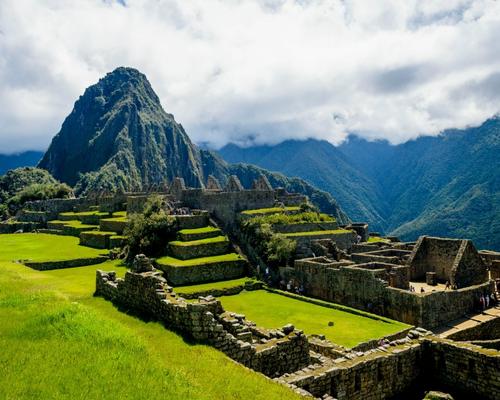 JANUARY
JANUARY
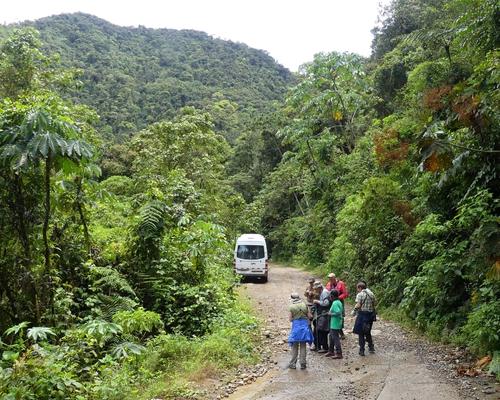 FEBUARY
FEBUARY
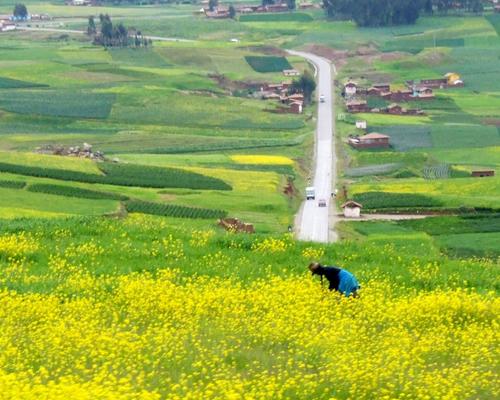 MARCH
MARCH
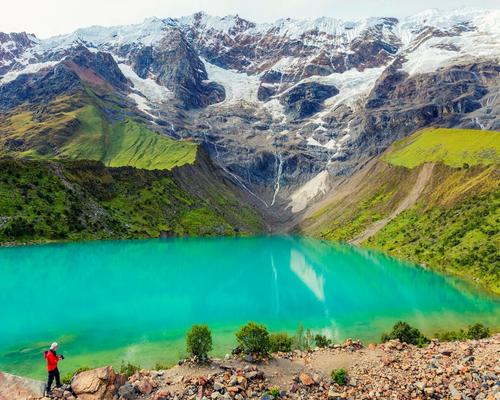 APRIL
APRIL
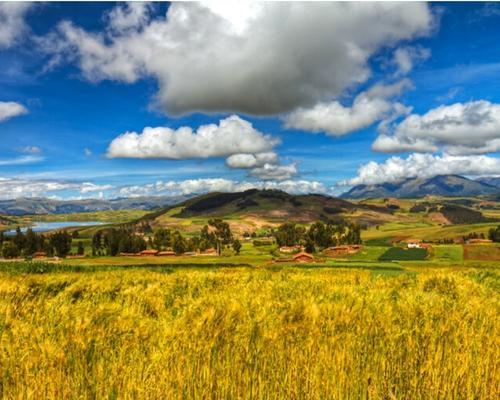 MAY
MAY
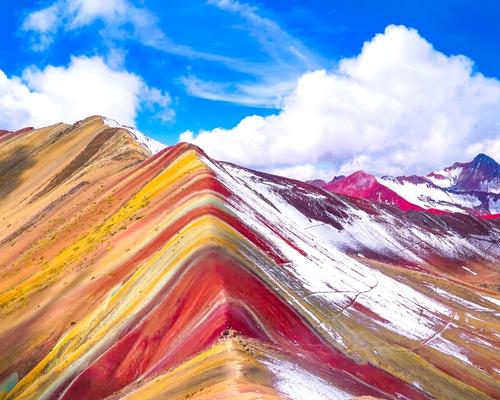 JUNE
JUNE
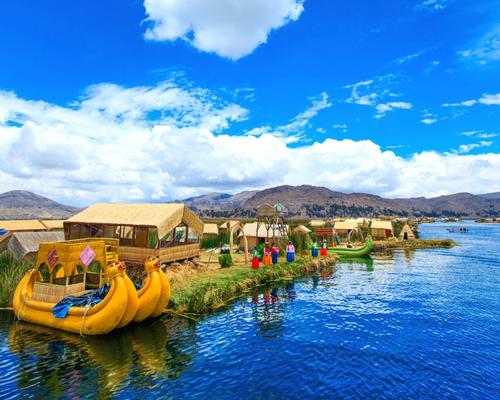 JULY
JULY
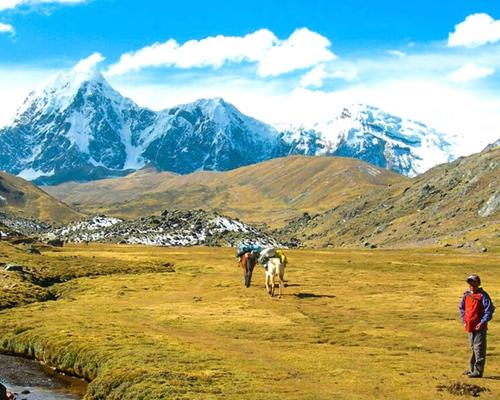 AUGUST
AUGUST
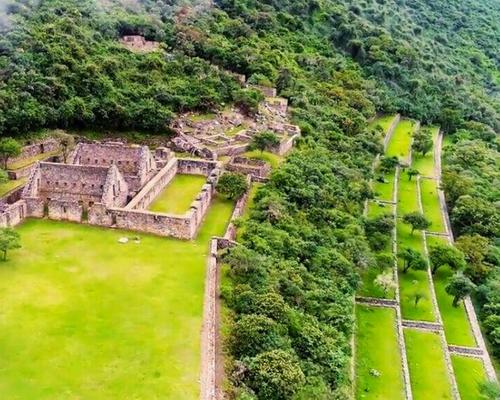 SEPTEMBER
SEPTEMBER
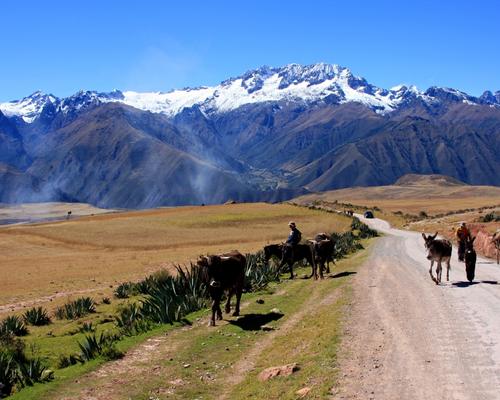 OCTOBER
OCTOBER
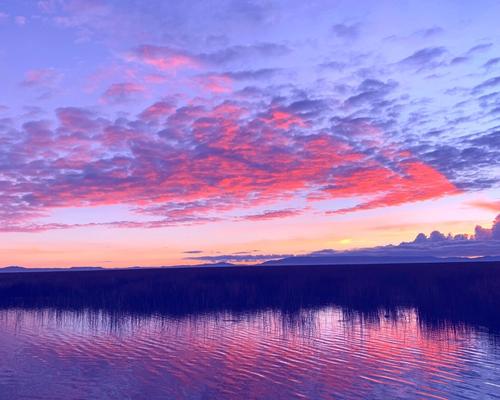 NOVEMBER
NOVEMBER
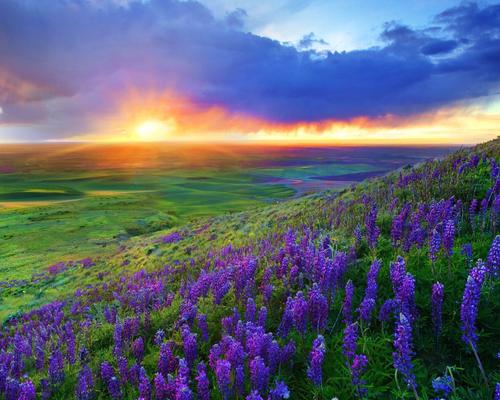 DECEMBER
DECEMBER
To book this tour, a minimum of $ 300 USD per person is required, the remaining balance will be paid upon arrival in Peru, at the Cusco office.
Any other additional information, please coordinate with your travel agent.
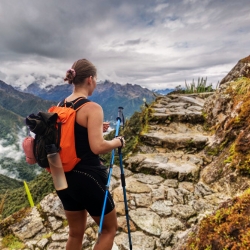
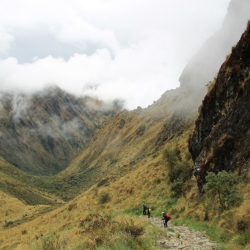
The Inca trail to Machu Picchu is one of the most fascinating excursions and full of much history, this is a religious type trail that at the time of the Inca empire was only used by the families closest to the Inca leader. Currently it is still possible to see their temples, aqueducts, houses and cultivation terraces that are preserved just as they left it more than 500 years ago.
Due to all the aforementioned connotations, many travelers want to visit this route to Machu Picchu every year, so the reservation for this attraction must be made at least 6 months in advance.
When Andean Great Treks receives your reservation request, it will immediately try to coordinate the reservation of your tickets for the Inca Trail to Machu Picchu, for this our work team must evaluate that the necessary spaces are available for you and your crew of cooks, porters and guides. Since according to the Inca Trail regulations, our company takes care of the health and protection of the worker, so each of our porters will only carry the allowed weights. We usually work with small groups (2 to 8 travelers) in private service for which we assign a sufficient number of porters who carry all the equipment such as tents, chairs, tables and food.
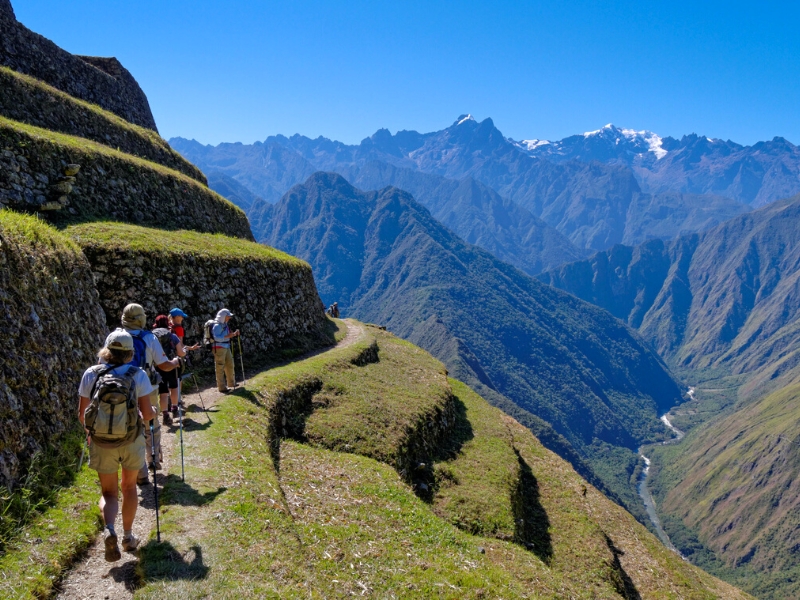
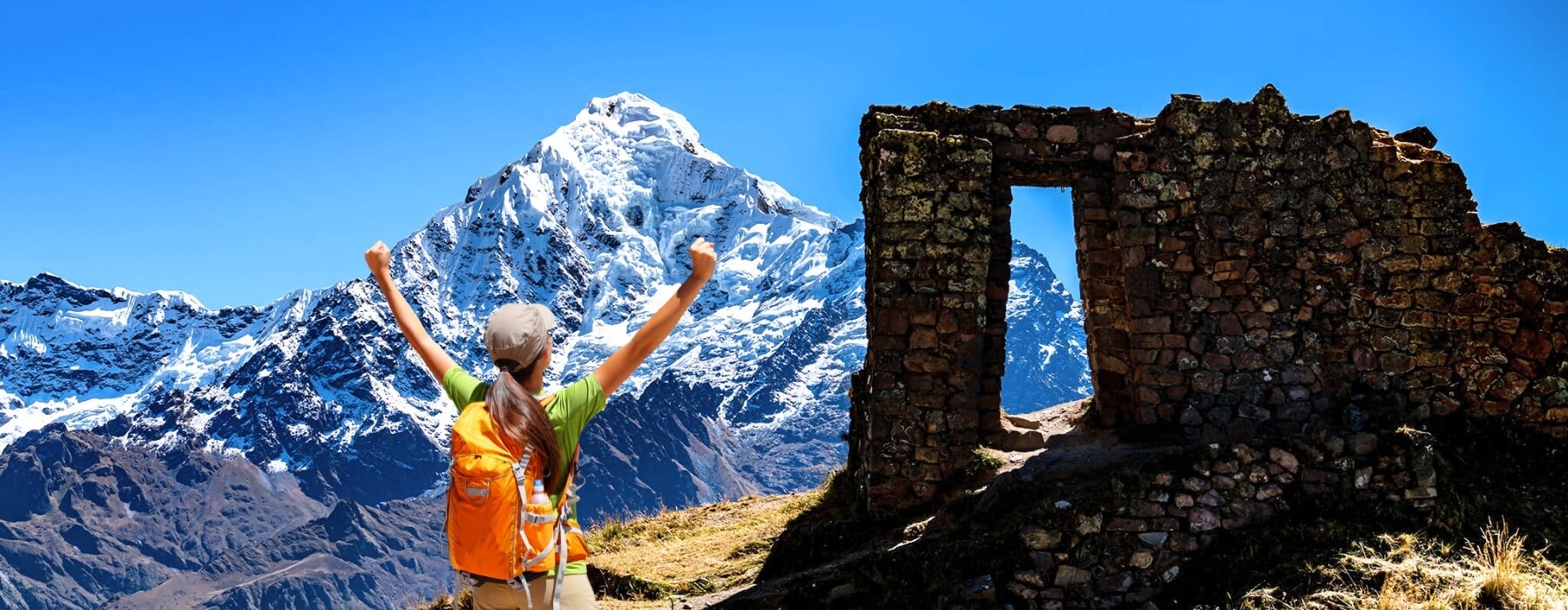
Nothing gets you closer to a country than walking through it, and we’ve got trips to suit walkers of all levels and interests.
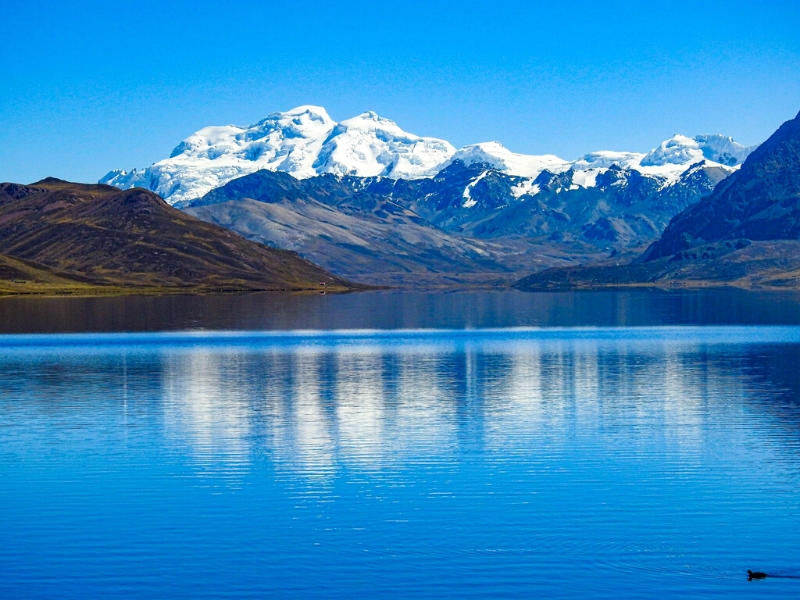
All our Walking trips are graded from ‘Easy’ through to ‘Challenging to Tough’. On our online trip itineraries you’ll find a chart showing the daily walk distances, timings and information on the route including the terrain, altitude. Generally, no specific training is needed but you might feel more comfortable if you’ve got out walking a few times in the lead-up to your trip.
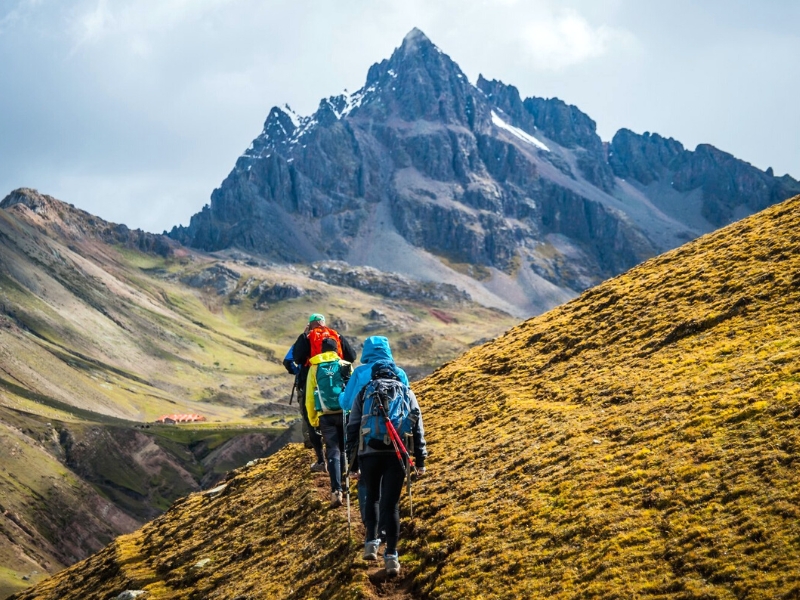
As with all our trips, every group is different but the ‘average’ group consists of roughly half couples and half solo travellers – all sharing a passion for exploring the world on foot. You’ll always have someone to keep you company along the route, but you don’t always have to walk together. Wherever possible your Andean Great Treks leader will allow everyone to walk at their own pace, regrouping regularly along the route.
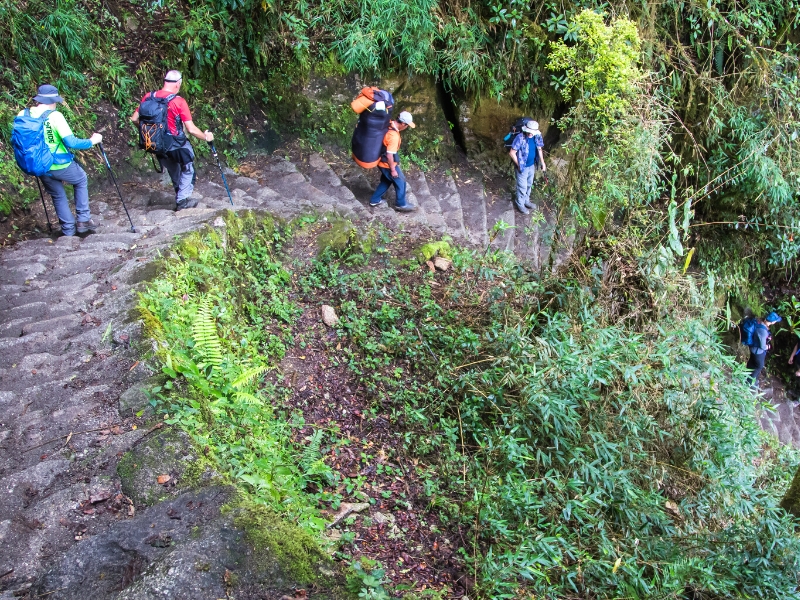
Mostly of our hikes in the mountains in Peru and Cusco like the classic Inca Trail to Machu Picchu, Ausangate Trek, Lares Trek, Ancascocha Trek, Salkantay Trek , involves an average of walking hours of 7-8 hours per day, this timing includes stops for taking photos, lunch, breaks for recovery the energy, and the most important we adapt to your walking pace. This relaxed style of trip involves to know all the attractions in greater depth.
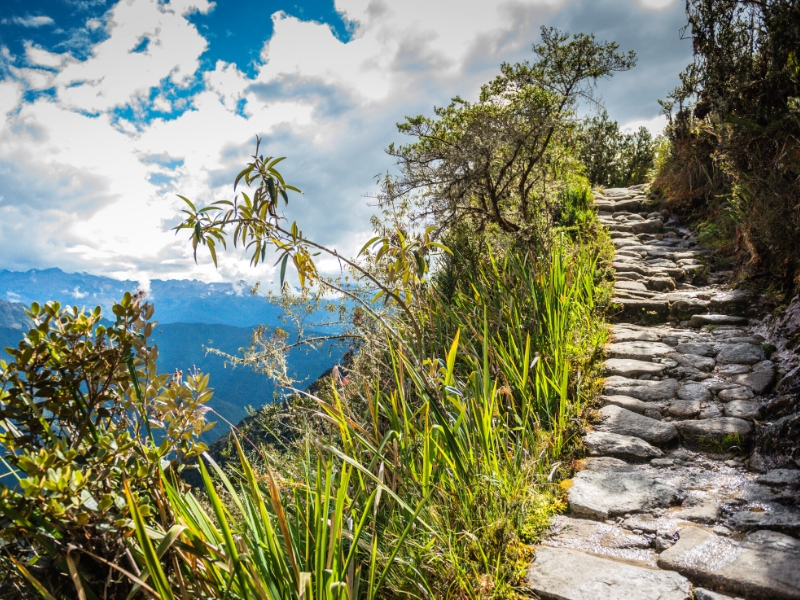
On nearly all our Walking trips, porters or mules will carry all the camping equimpent, so your main luggage will be transported for you. We recommend walk with a light rucksack, you will carry water, snacks, a camera, a small first aid kit and any extra clothing or sun protection. On more remote or challenging treks, additional guides are there to assist the leader tour guide and provide support to the group.
Along the trek, you will walk through different terrains, and experience diverse microclimates and altitudes. All of these factors contribute to the great biodiversity that is unique to this area.
The permits or entrance ticket for the Inca Trail Hike includes the entrance to Machu Picchu citadel, but it does not include the entrance to the extra hikes to the mountains from where you can see the citadel from above.
For example, Huayna Picchu mountain costs $80 USD per person. In case, you want to hike it you have to buy the entrance ticket to the mountain in advance.
Actually, there is no government restriction on the age limit for the inca trail to machu picchu. However, because of the challenging trek, we consider it to be best for visitors above 15 years old to 55-year-old adults. Of course, they must be in good physical condition. Certainly, In case a child travels with you, you may need to hire the service of a personal porter who will assist your child along the hike and carry his backpack.
Above all, Adults over 55 years old, should have hiking experience and be in good health condition. This way, they will be able to arrive in Machu Picchu safely.
From 1 to 5 it’s 3, moderately difficult. The Inca stairways to walk up and down in different temperatures and high altitude all that makes this level of difficulty. You can rent walking poles before you start your hike. Those will help you in many ways, we would recommend you get ones if you have some issues with knees or ankles, poles would absorb some pressure from those parts and also help to keep your balance! We recommend you to have a look how to prepare yourself for the Inca Trail.
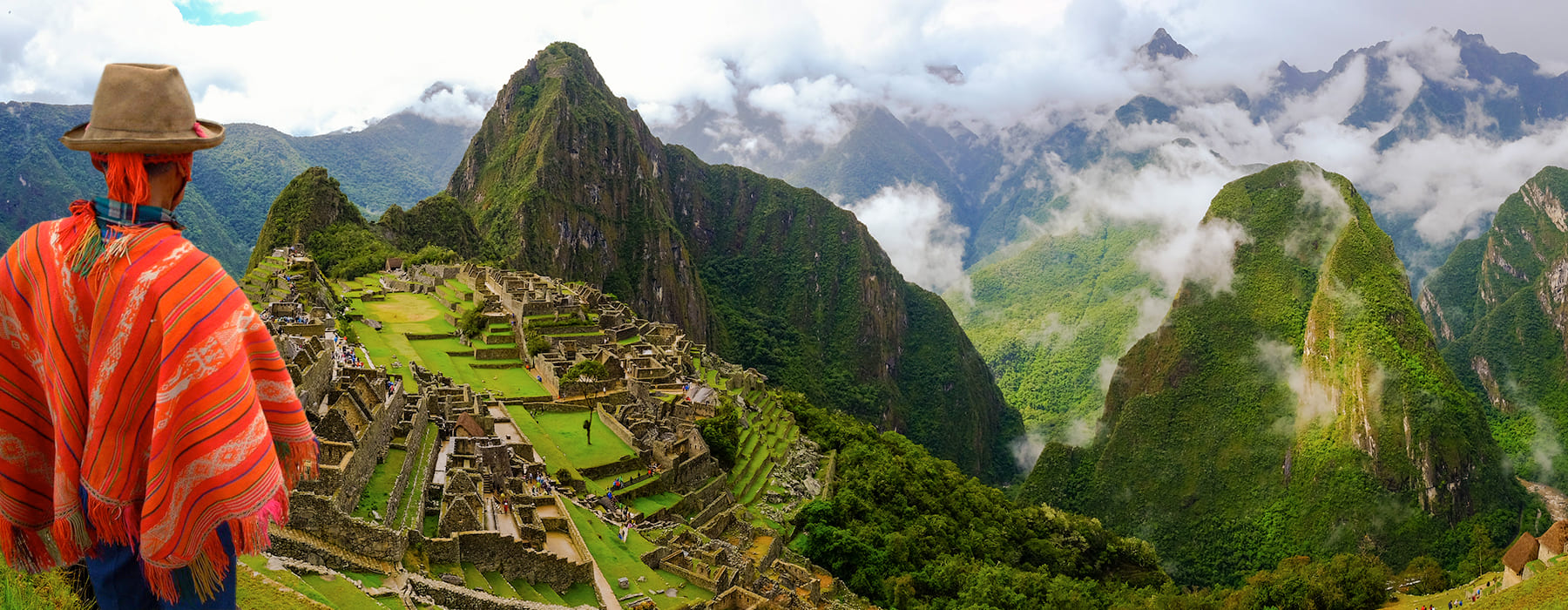
Every Andean Great Treks holiday has been thoughtfully planned and crafted by our specialists. They draw on their own extensive travel experience and the guidance and expertise of our local partners to create superb holidays. Our specialists are committed to making every aspect smooth and enjoyable; they genuinely want to ensure that the holidays they create leave you with wonderful lasting memories.
Every Andean Great Treks traveller is accompanied by an experienced tour guide, you will be immersed in Historic cities, ancient ruins and unfamiliar landscapes are all brought to life by our carefully selected local guides. They want to share their expertise and help you make your own discoveries too; their sole mission is to ensure you enjoy every moment.
Giving you the freedom to make your holiday even more memorable. We know how much our customers look forward to their holiday and we pride ourselves on the choice and flexibility that we offer to enhance every aspect of your experience. Whether it’s getting to the airport, upgrading your room or booking an additional excursion, we can help.
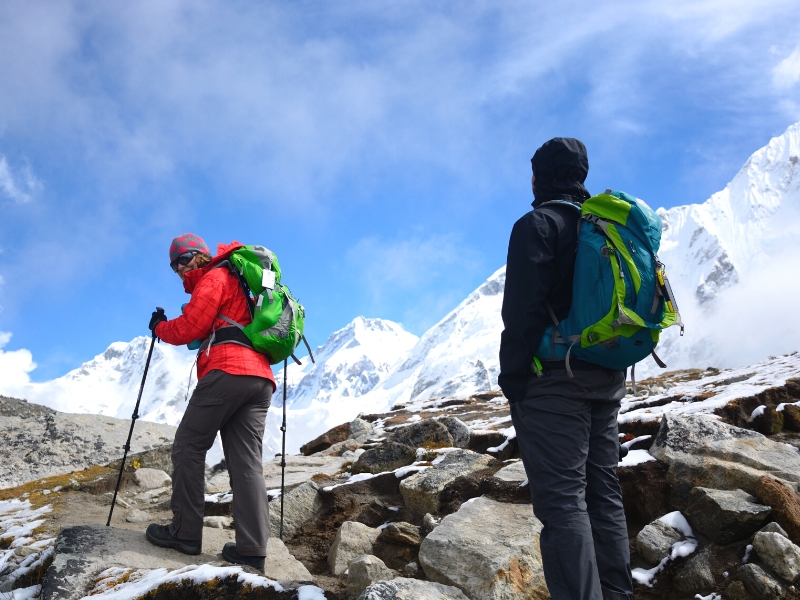
Our guides are the stars of the show; it is their unrivalled knowledge, passion and expertise that will transform your tour experience from good to truly extraordinary!
Because the have grown up in the area and know it like the back of their hand, so they can help you experience whichever aspects most interest you. They’re passionate about sharing their corner of the world with you, and as you explore together, they’ll open your eyes to the intricate details, provide background to enhance your understanding of what you’re seeing, and share stories that will bring everything to life.
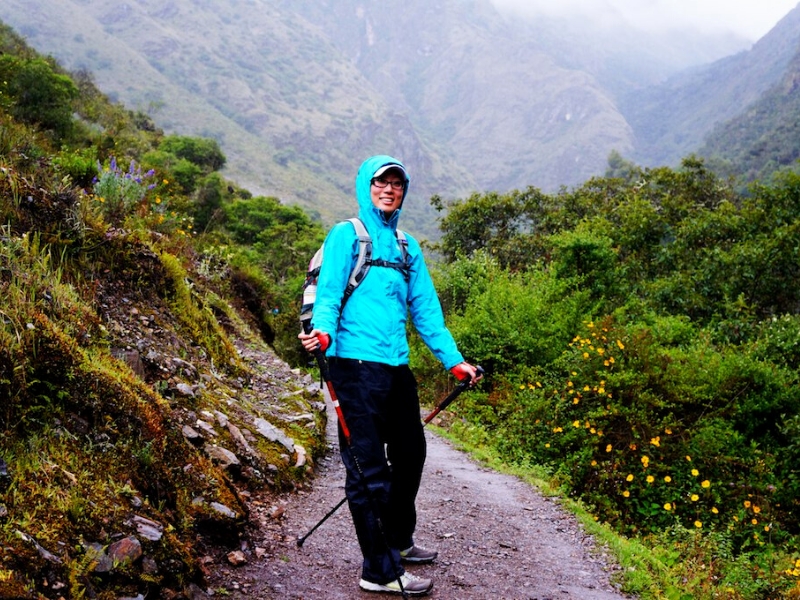
“Your inspiration for a trip can be a single word or a highly evolved outline, but it’s the conversations we have that help us understand the experience you’re looking for. Meanwhile, I’m looking back on the time I spent at the destination.
‘The great thing about working with a specialist at Andean Great Treks is how they take your complete jumble of ideas and turn them into something absolutely spectacular.’
As you begin to share your ideas with your specialist, it will connect them immediately back to a time in their own travels. Conjuring a picture of the rest time they made that same discovery, reminding them how it felt.
Your specialist understands that, when the journey is right, it has the power to excite your emotions in the most profound ways after all, that was the effect on them.
They carry a treasure box of moments, captured over many journeys, into every suggestion they’ll share with you, as they ask you how you want to feel on your trip.
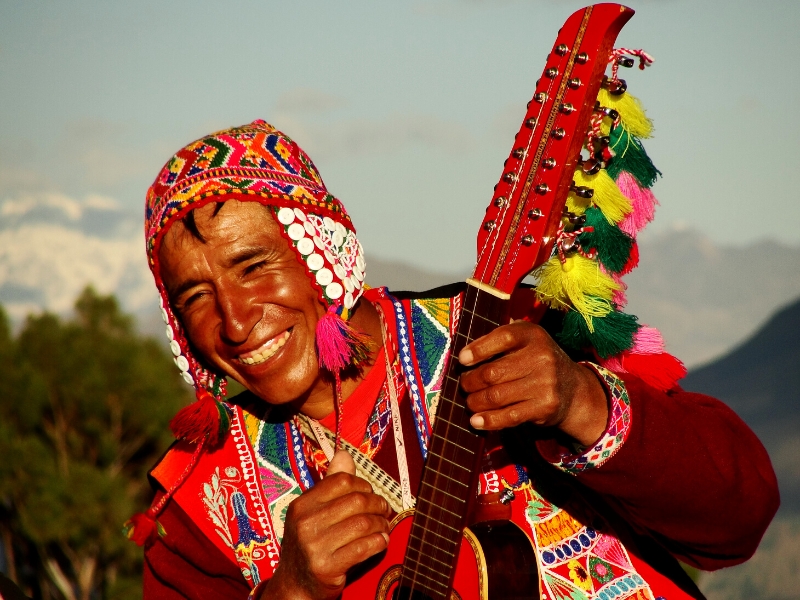
EXPERIENCES THAT CALL TO YOU
It’s what you do in a destination that helps bring it to life. It’s why we strive to choose experiences that help you connect to a place, absorbing a little of its complex character. Wherever your passions lie, we’ll recommend experiences that speak to you, and we’ll recommend the guide or local expert who’s most qualified to help you explore. Packing your holiday full of special experiences means some early starts and long days, but you can be sure that you’ll return home with many incredible memories! Read our Tours and check the Physical Ratings to see if the pace and activity levels are right for you.
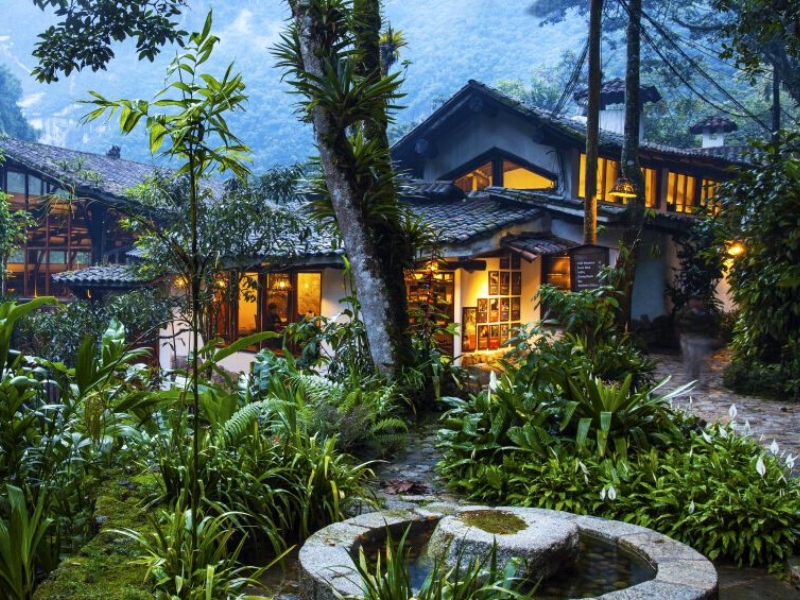
STAYS WITH DIFFERENCE
We know that where you stay is a cherished part of your travels. So, we go to great lengths to find places to stay that exceed expectations, or go above and beyond the ordinary, whether in their character, hospitality, or location. Over the years, we’ve discovered the very best properties, trying and testing them, so we can choose the right one for you. We’ve nourished long-standing relationships with these establishments and the people who founded them, and we’ve stayed there many times often, we’ll even know which rooms have the best views (and reserve them for you).
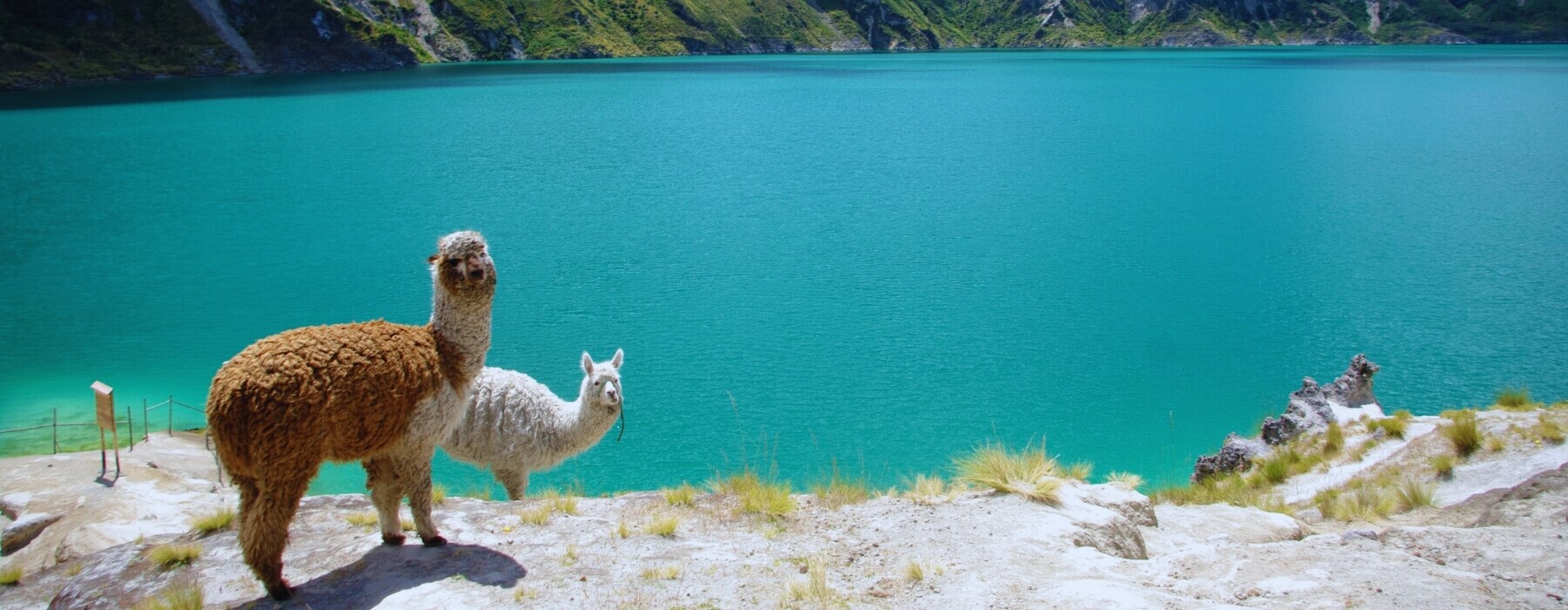
Our style of travel — authentic, thoughtful, and focused on building meaningful connections to the people and places you visit — is inherently respectful and considerate of the destinations we love. We design each aspect of your trip exactly as you want it, which includes its sustainability. That might mean choosing a train journey instead of a flight, staying at eco-friendly wildlife lodges, or opting for experiences that give back to the communities you’re visiting. The choice is yours.
Responsible travel has always been at the heart of what we do. First and foremost, because it gives you the best experience, but, also because it helps to preserve the communities and landscapes you visit. This isn’t new for us we collaborated with local communities and outside experts so we can grow to be better ambassadors.
The most authentic and interesting experiences often directly benefit the local people. We prefer to buy local products that are produced in the organic farms of the Sacred Valley, we also have alliances with local artisan organizations who provide us with souvenir items for our clients, your money directly benefits the local economy.
Our style of travel — authentic, thoughtful, and focused on building meaningful connections to the people and places you visit — is inherently respectful and considerate of the destinations we love. We design each aspect of your trip exactly as you want it, which includes its sustainability. That might mean choosing a train journey instead of a flight, staying at eco-friendly wildlife lodges, or opting for experiences that give back to the communities you’re visiting. The choice is yours.
Responsible travel has always been at the heart of what we do. First and foremost, because it gives you the best experience, but, also because it helps to preserve the communities and landscapes you visit. This isn’t new for us we collaborated with local communities and outside experts so we can grow to be better ambassadors.
The most authentic and interesting experiences often directly benefit the local people. We prefer to buy local products that are produced in the organic farms of the Sacred Valley, we also have alliances with local artisan organizations who provide us with souvenir items for our clients, your money directly benefits the local economy.
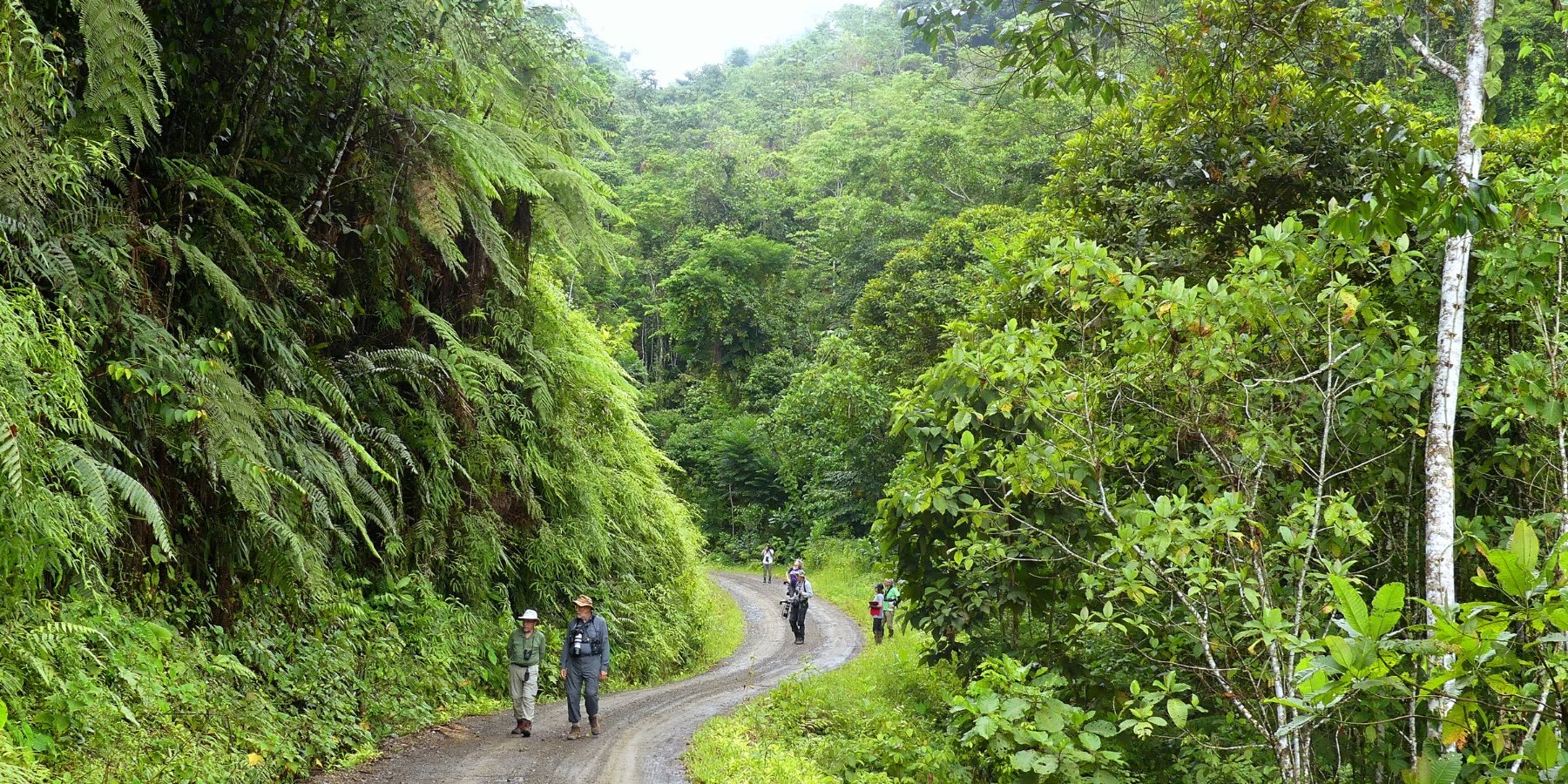
‘There’s a saying: we don’t inherit the Earth from our ancestors, we borrow it from our children. When we show you our country, this philosophy guides everything we do. It’s our responsibility to preserve the environment and wildlife, and support communities. That means using slower modes of transport, like cycling, employing local people, and working with communities who’ll benefit directly from your visit. This also gives you the best, most authentic impression of the places we want to share with you.
We prefer to buy local products in ecological bags, to avoid the use of plastic bags, likewise we teach the use of soaps and ecological products in each tour that we organize. We also work on reforestation projects with local communities who take care of landscape resources such as communal reserves, national parks.
‘There’s a saying: we don’t inherit the Earth from our ancestors, we borrow it from our children. When we show you our country, this philosophy guides everything we do. It’s our responsibility to preserve the environment and wildlife, and support communities. That means using slower modes of transport, like cycling, employing local people, and working with communities who’ll benefit directly from your visit. This also gives you the best, most authentic impression of the places we want to share with you.
We prefer to buy local products in ecological bags, to avoid the use of plastic bags, likewise we teach the use of soaps and ecological products in each tour that we organize. We also work on reforestation projects with local communities who take care of landscape resources such as communal reserves, national parks.
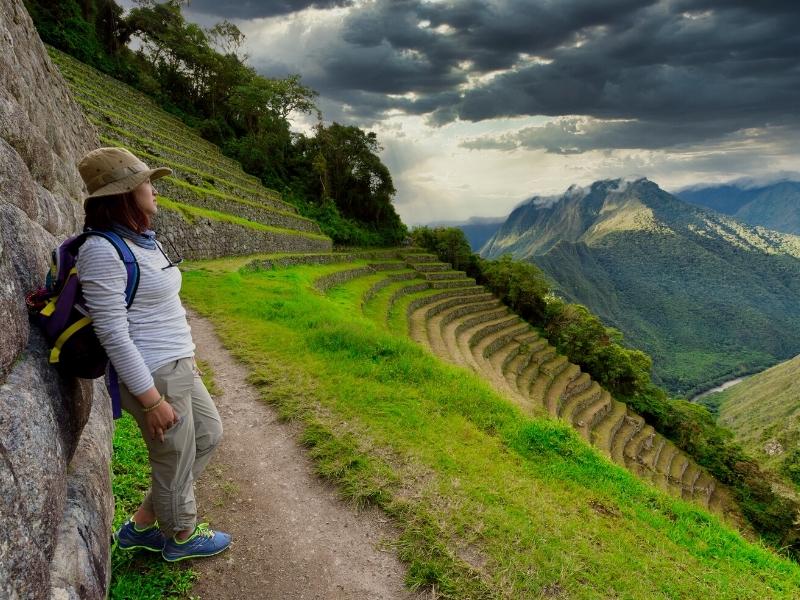
The 2-day Inca trail to Machu Picchu, is the shortest version of the Inca trail circuits to the sacred citadel of Machu Picchu. Andean Great Treks organize this trek with the best local guides and hotels in Machu Picchu. We work only in small groups, the premium service for your delight in Cusco.
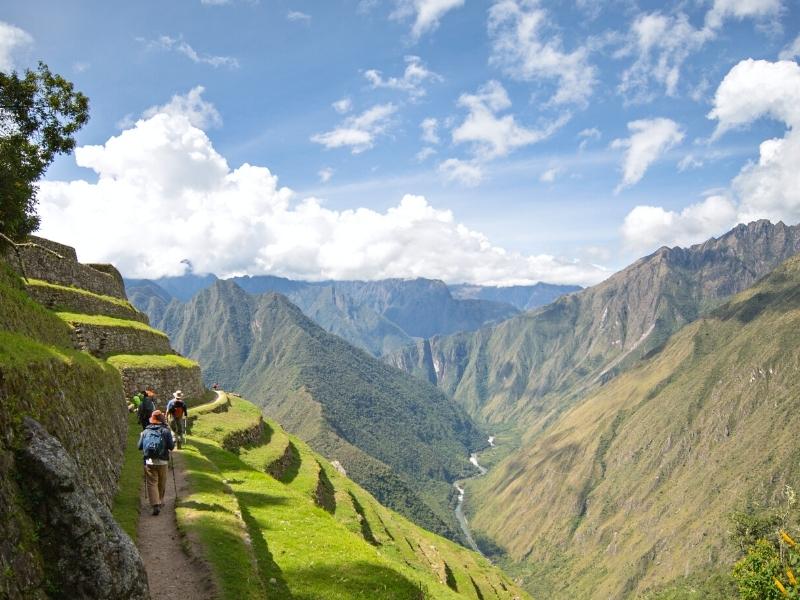
The classic Inca Trail hike to Machu Picchu is one of the world's greatest hikes. Along the 45 km you will explore unique andean valleys, lush mountain forest.An exquisite architecture of the Inca sanctuaries, which will dazzle you for its fineness and location within the Andes.
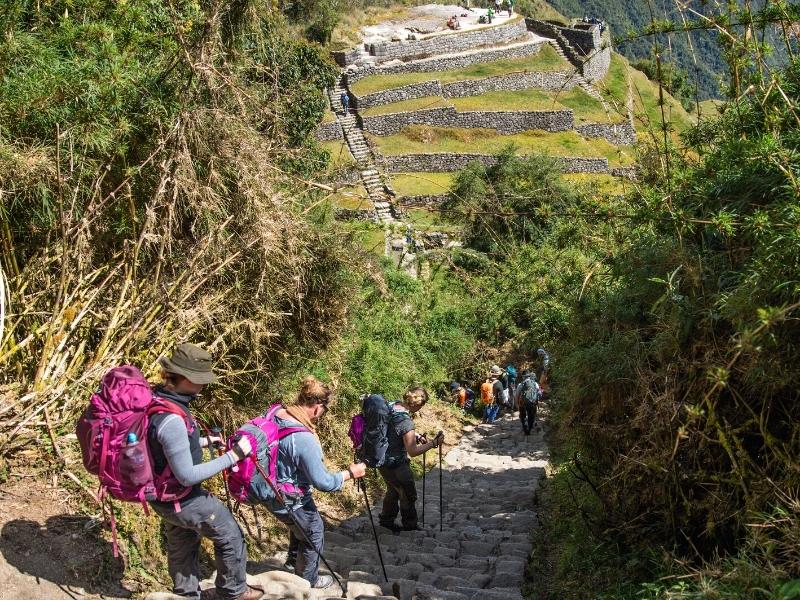
The 5-day Inca Trail to Machu Picchu is a trek that will show you the best landscapes and Inca ruins. This option is recommended for lovers of culture and a more leisurely pace of walking.